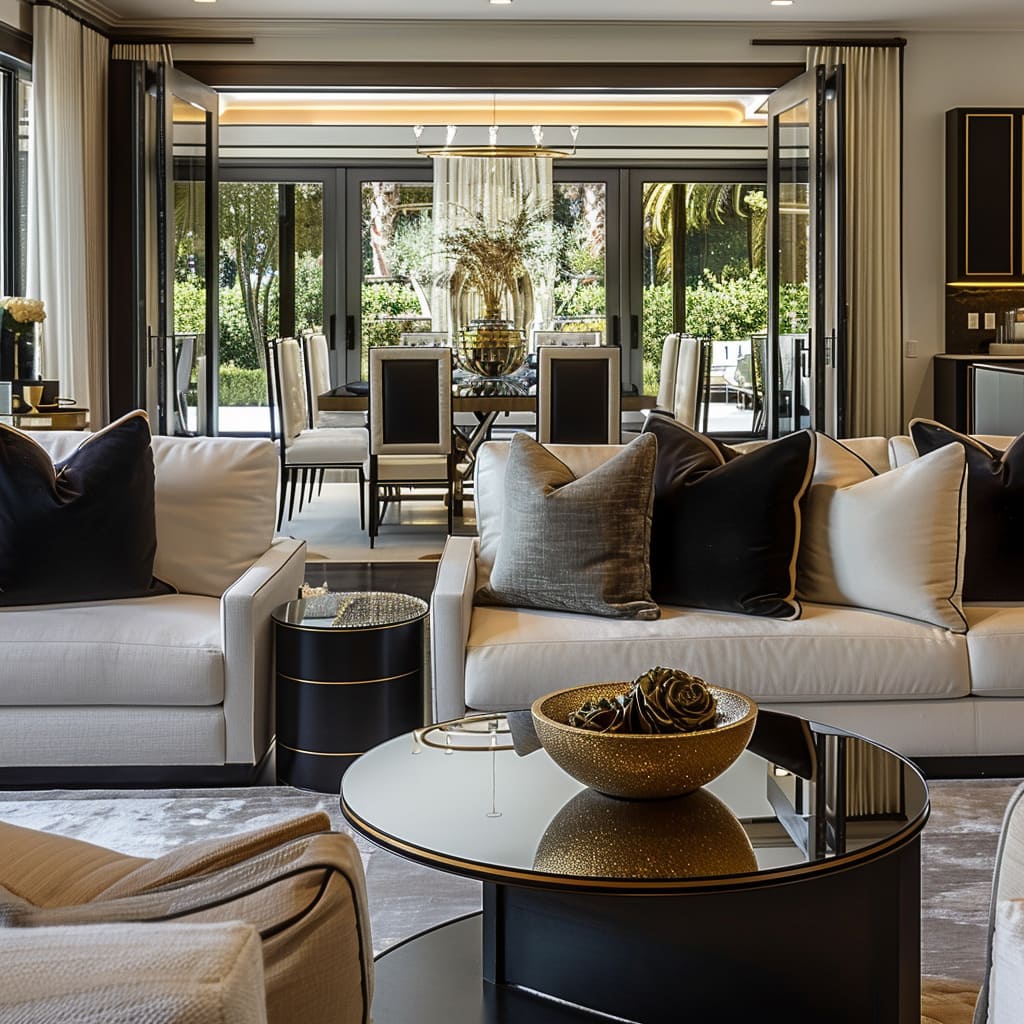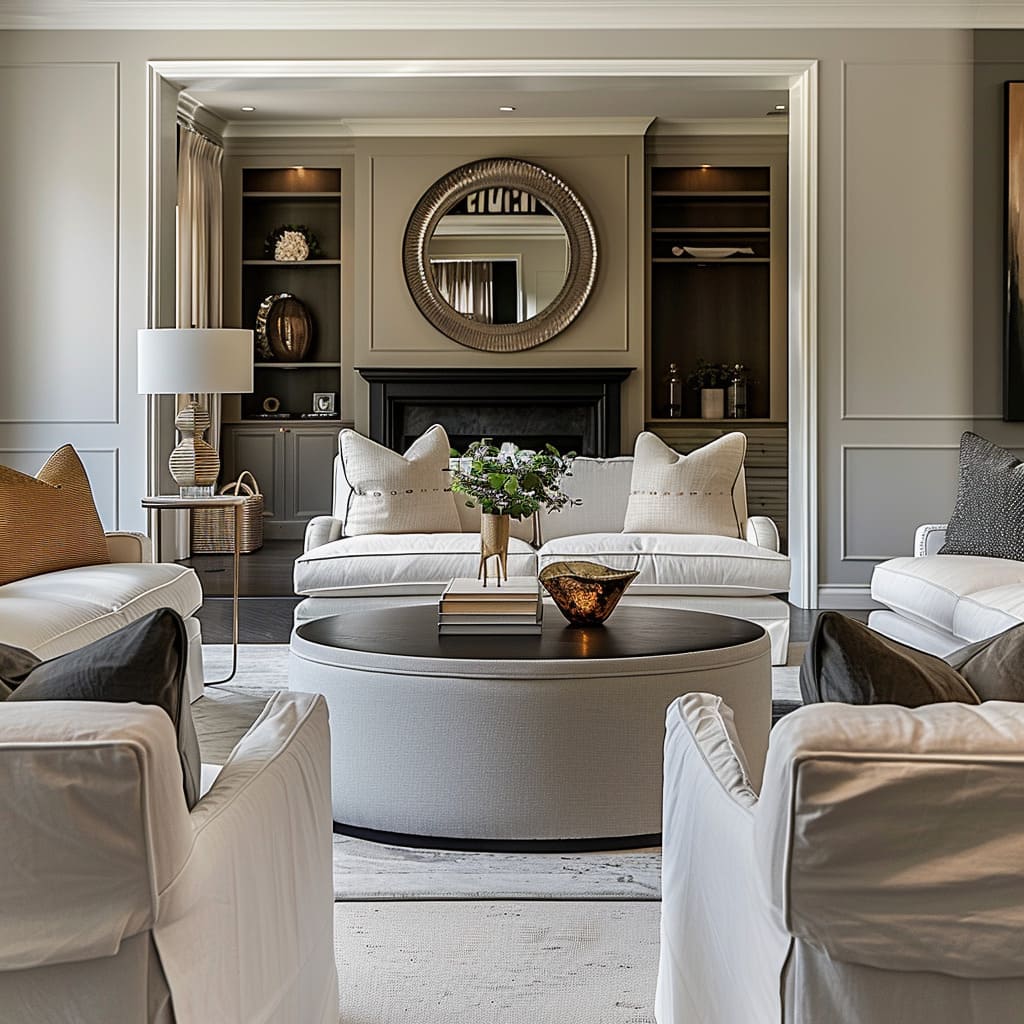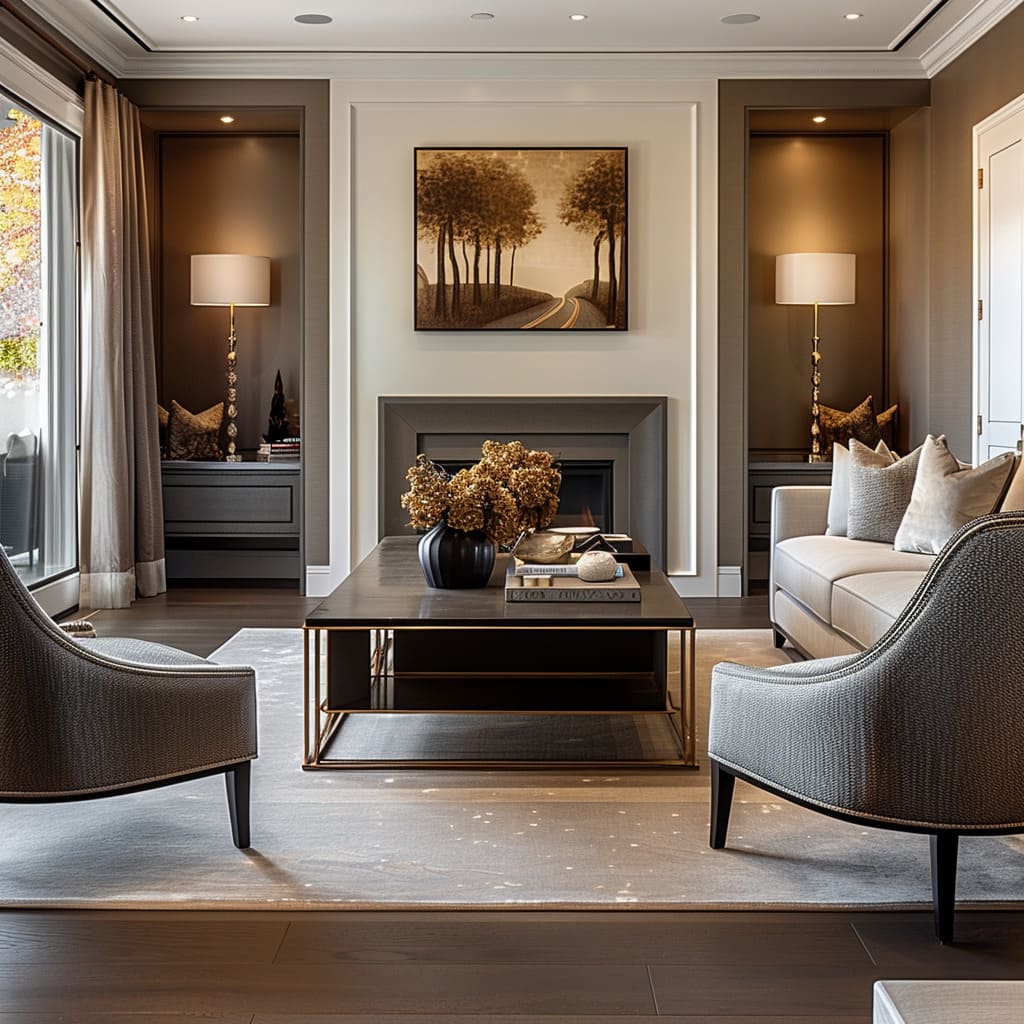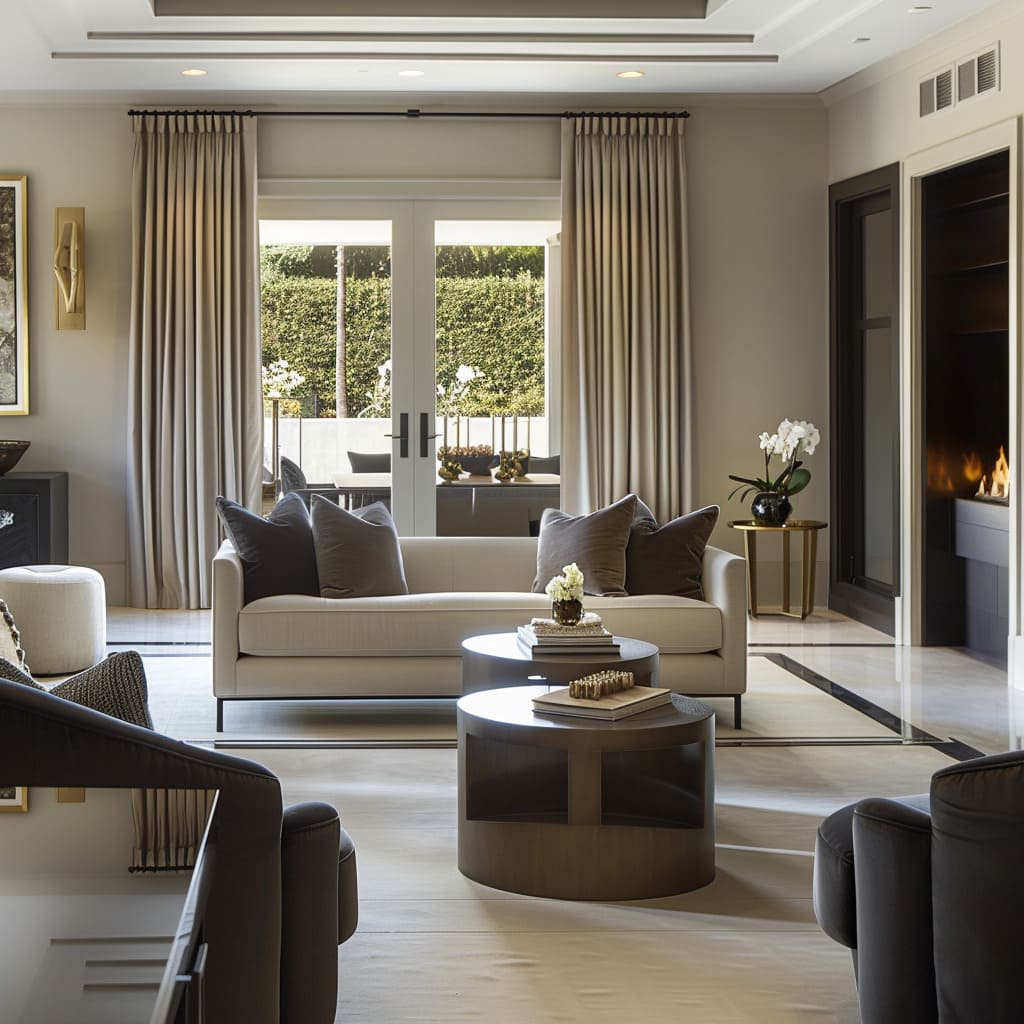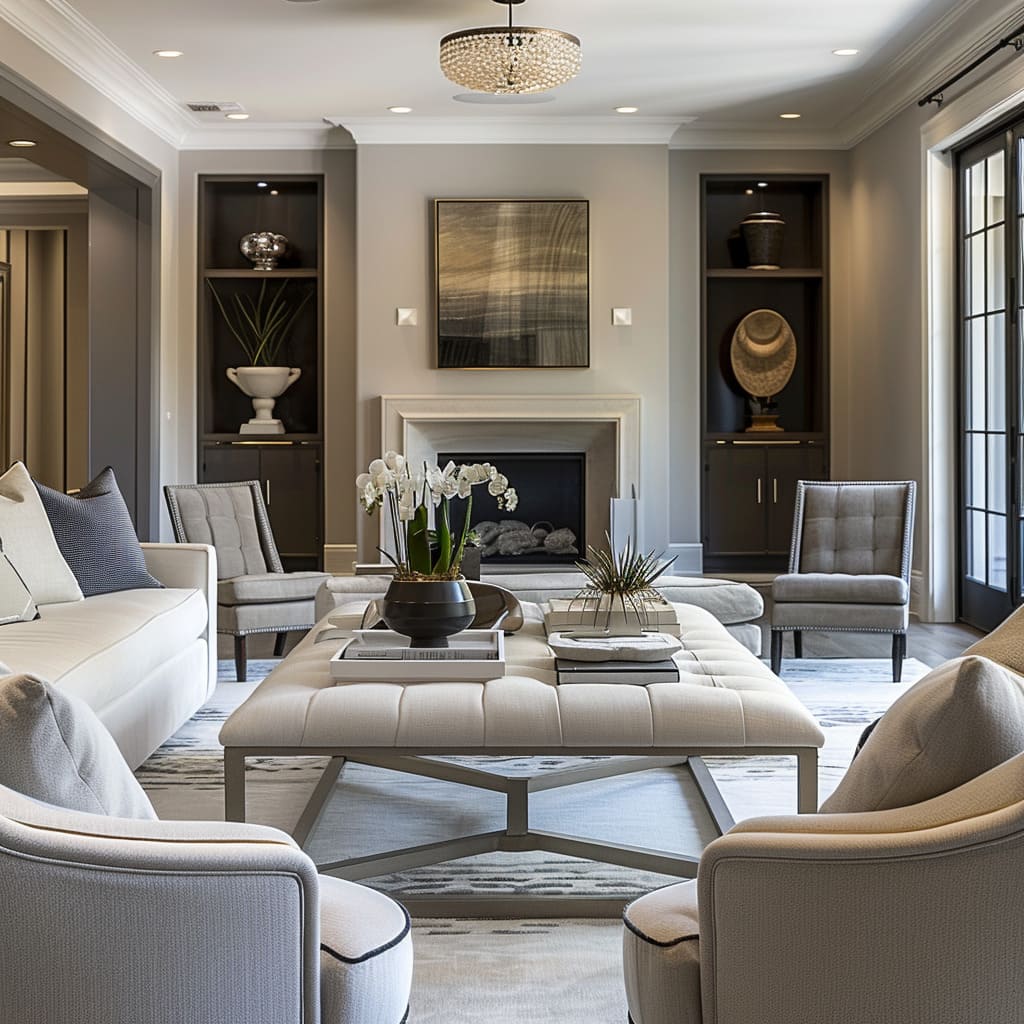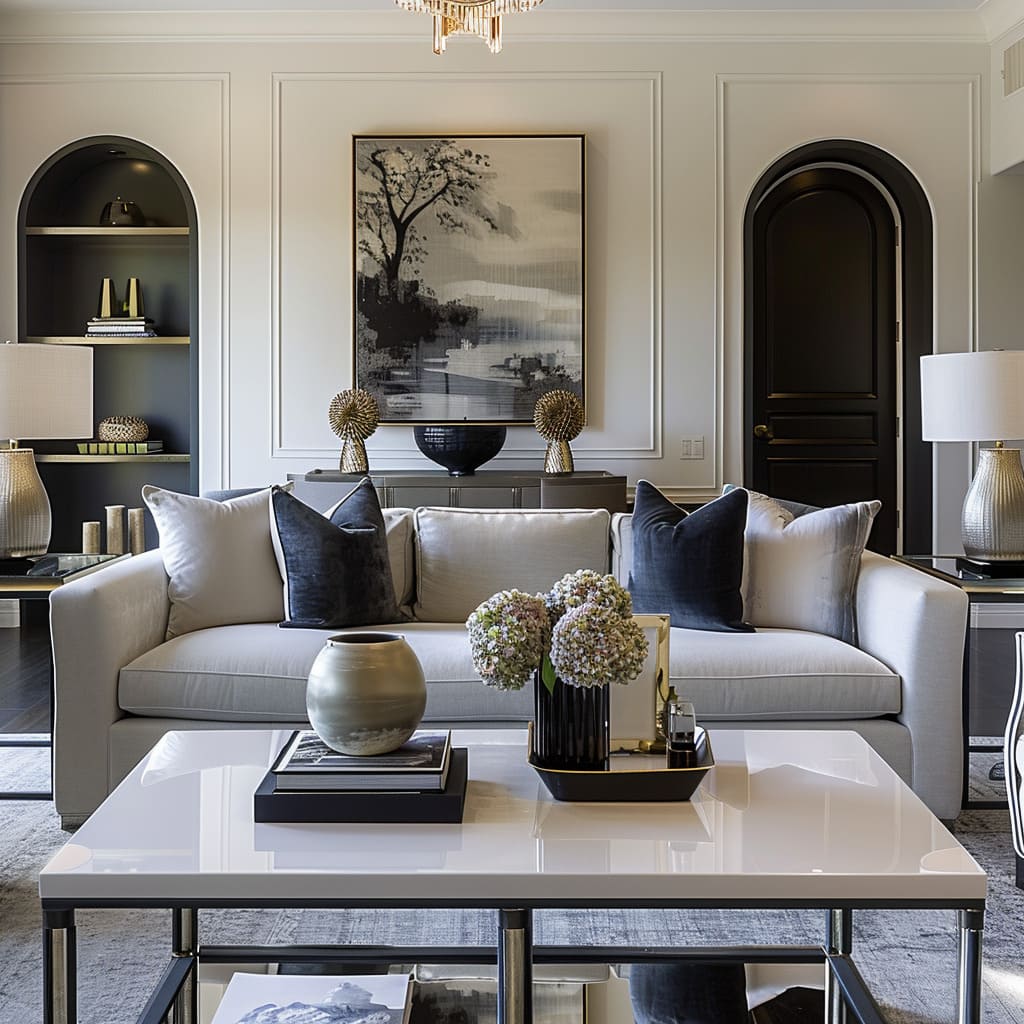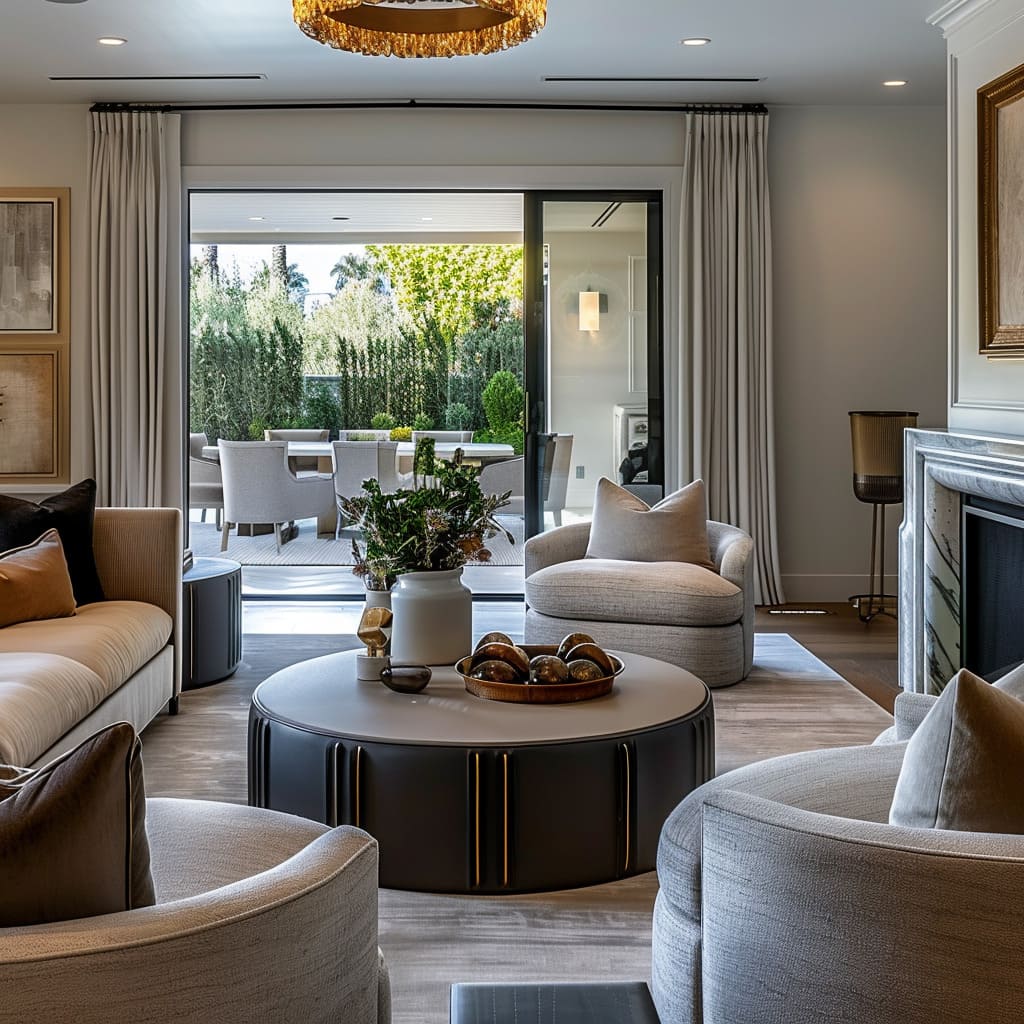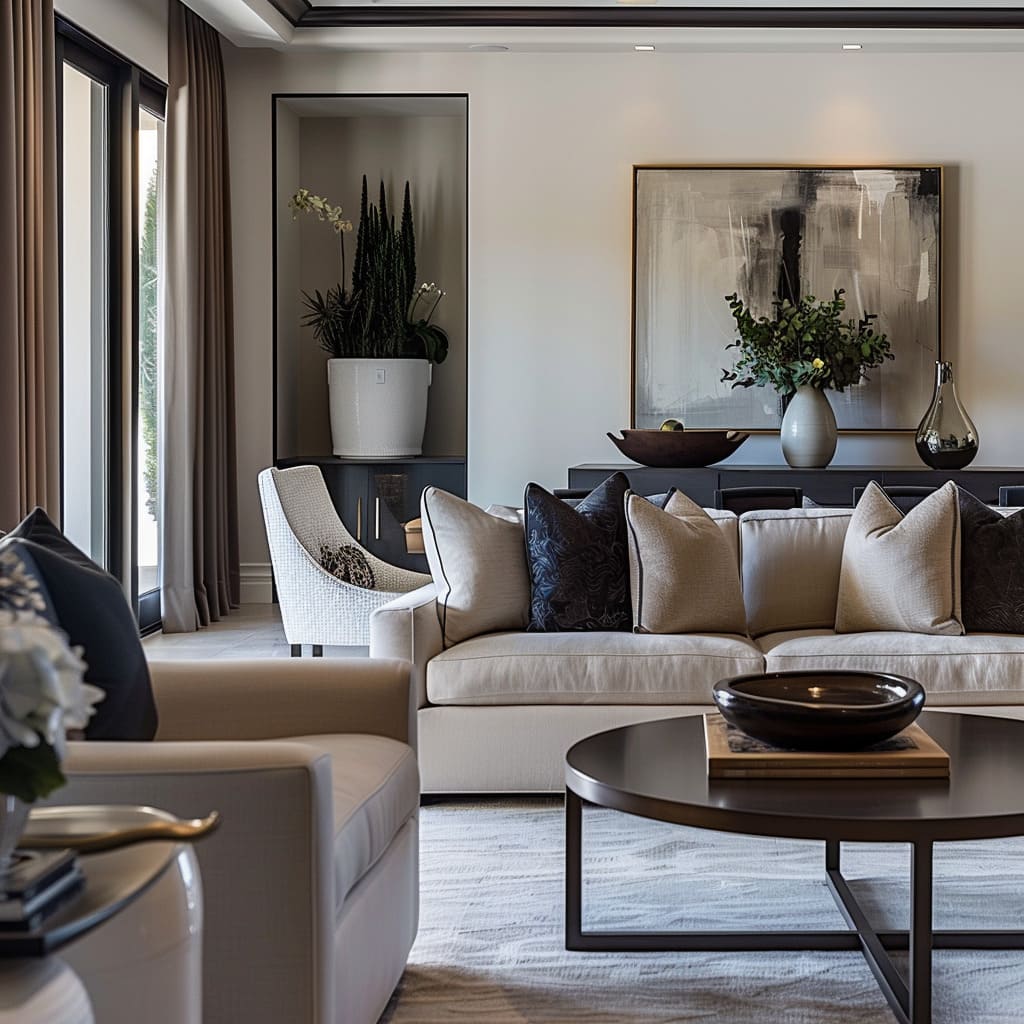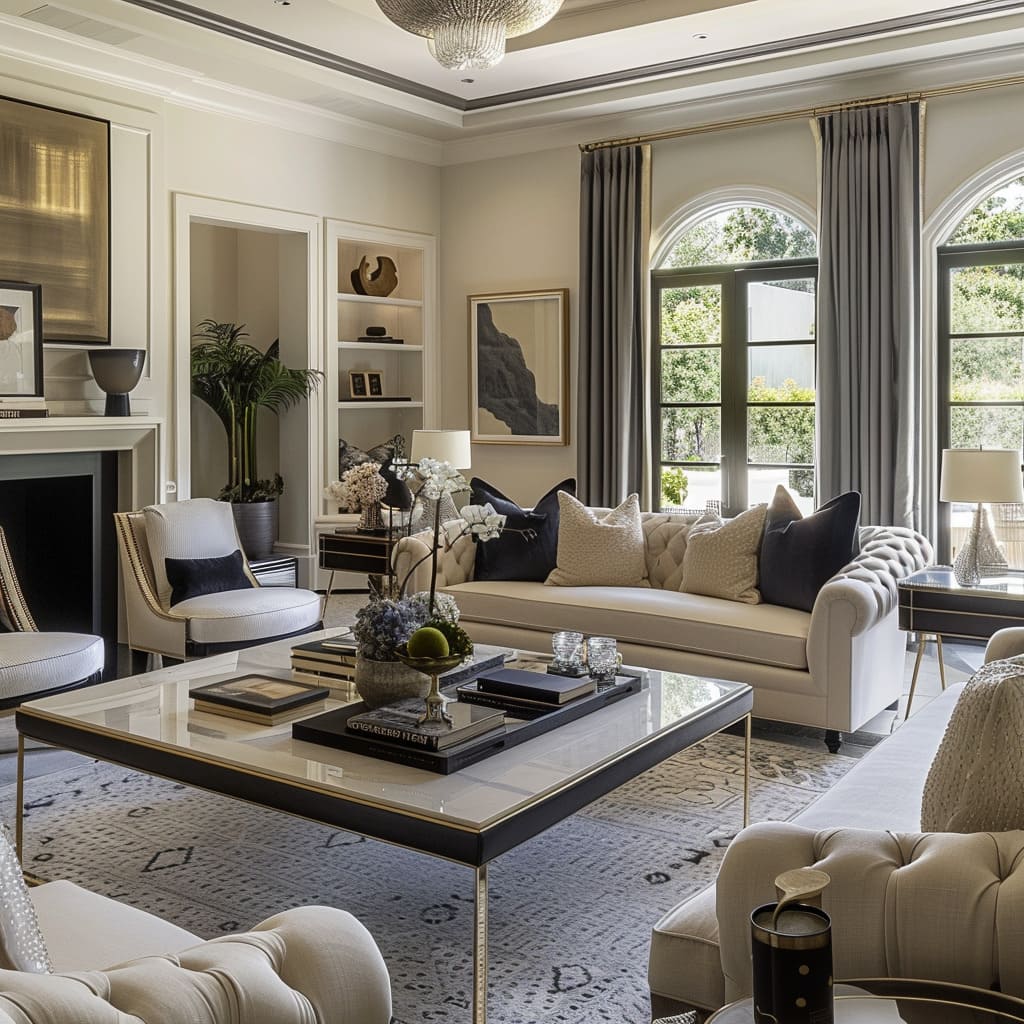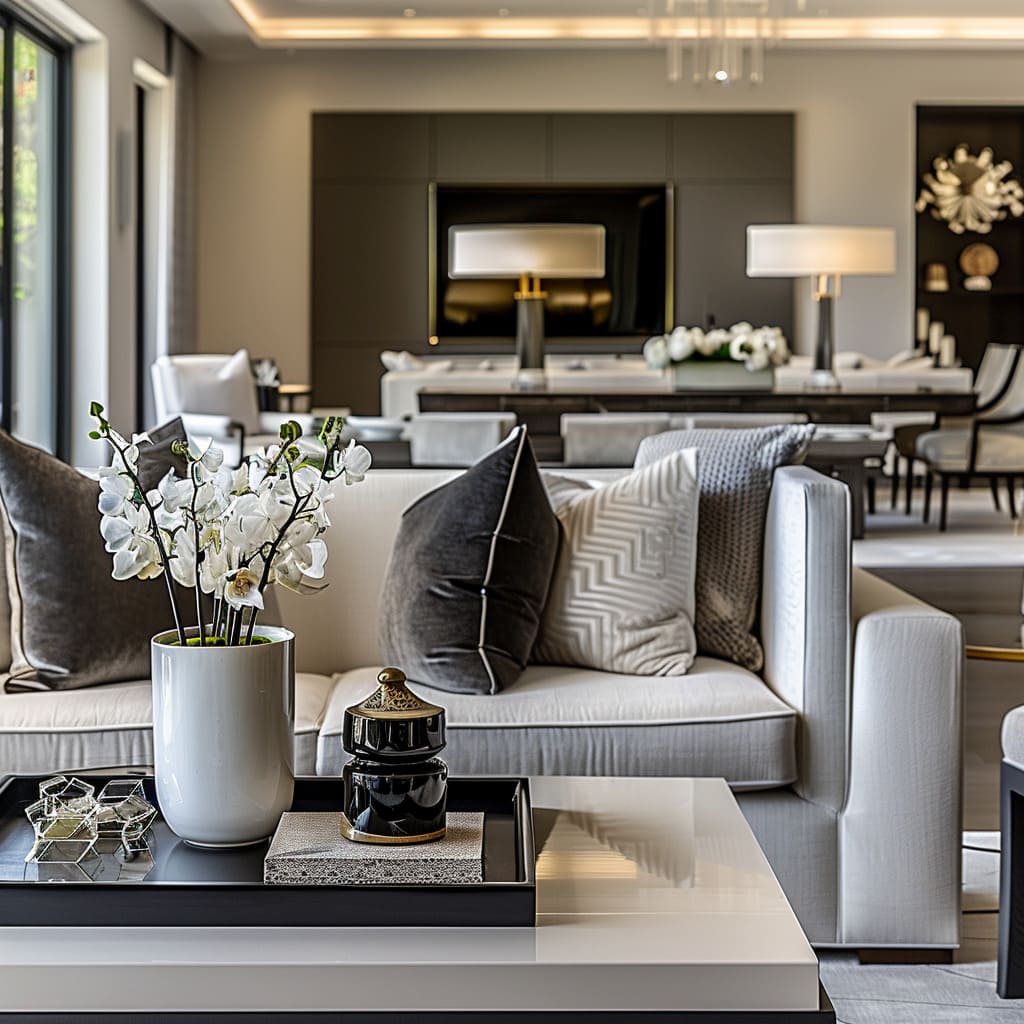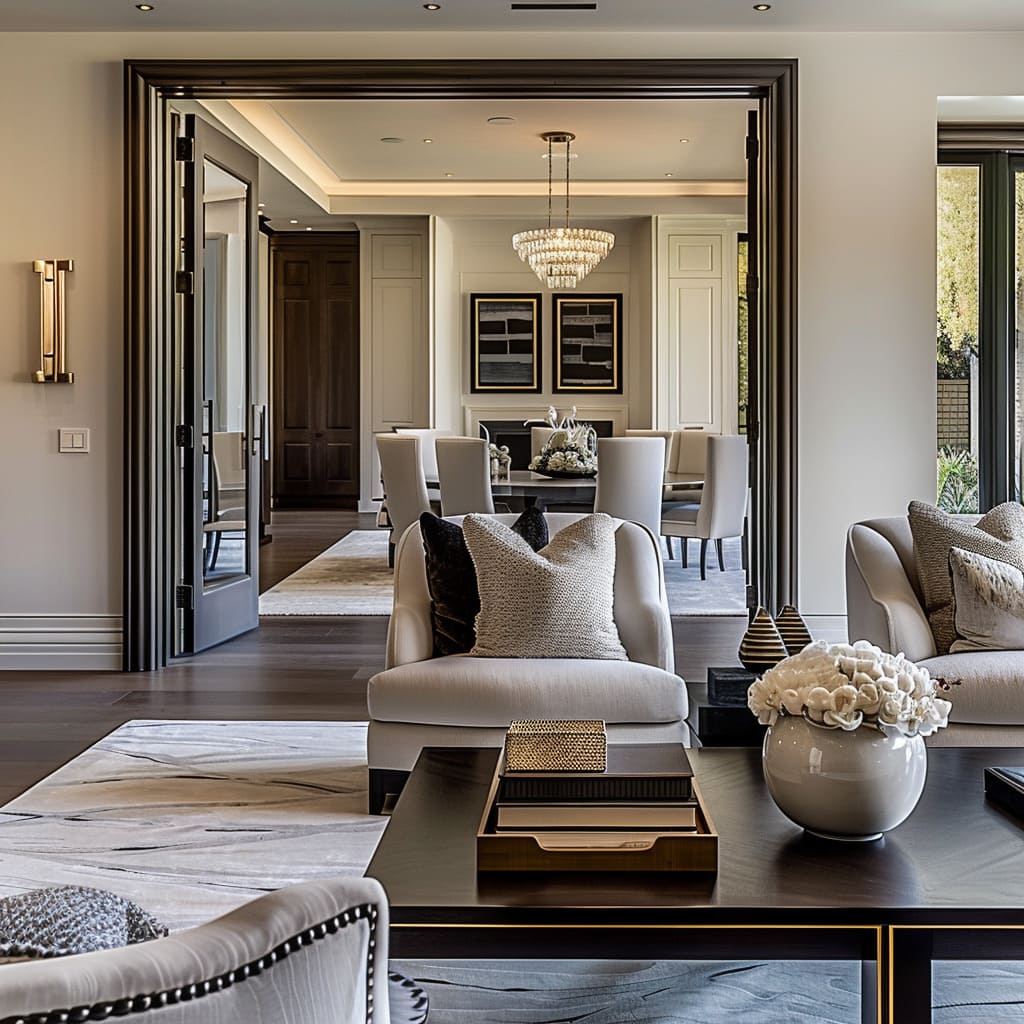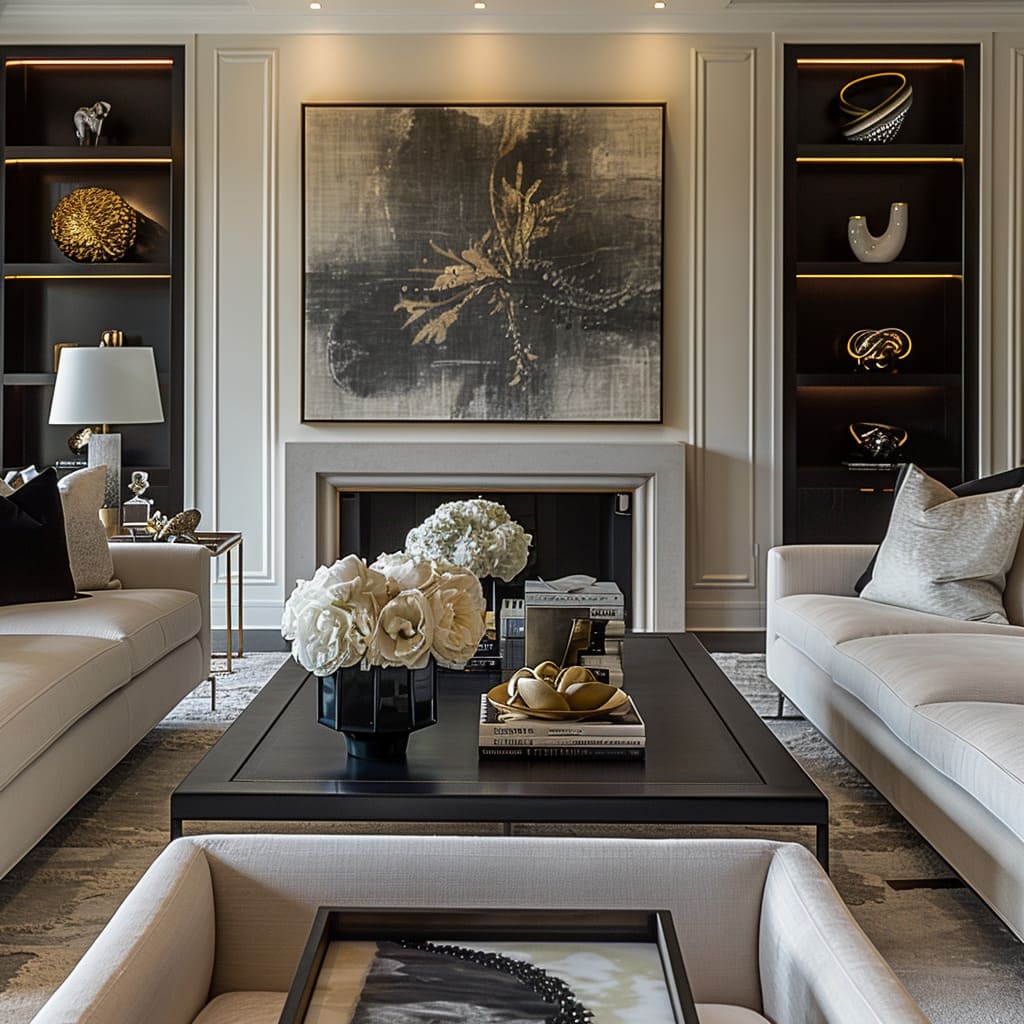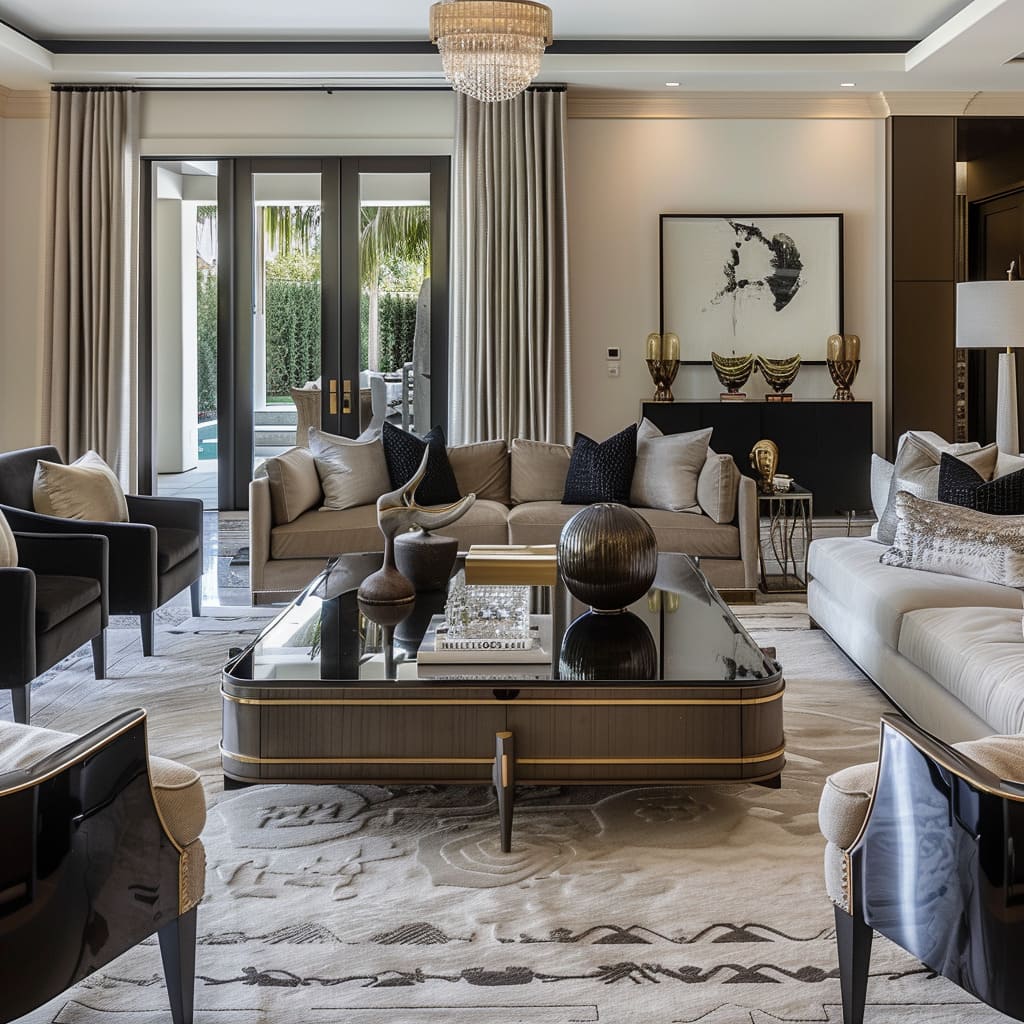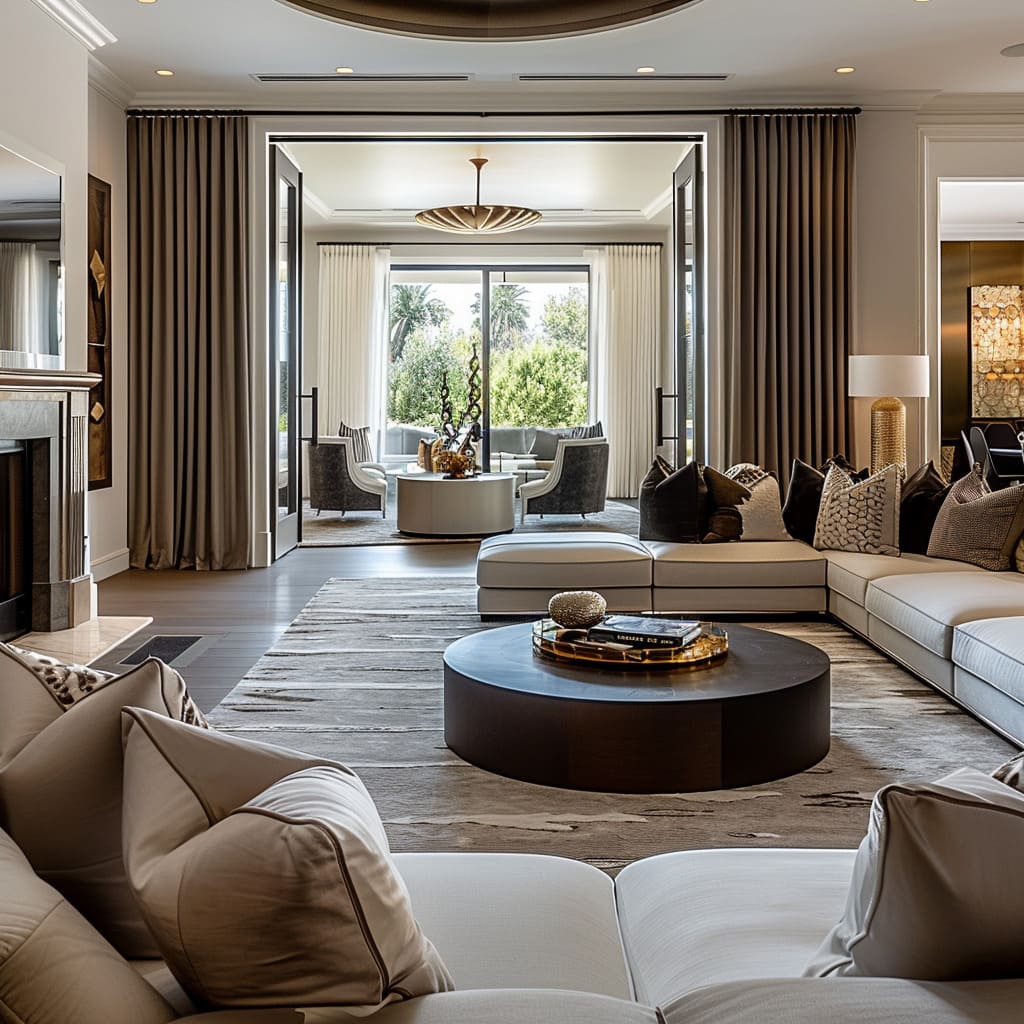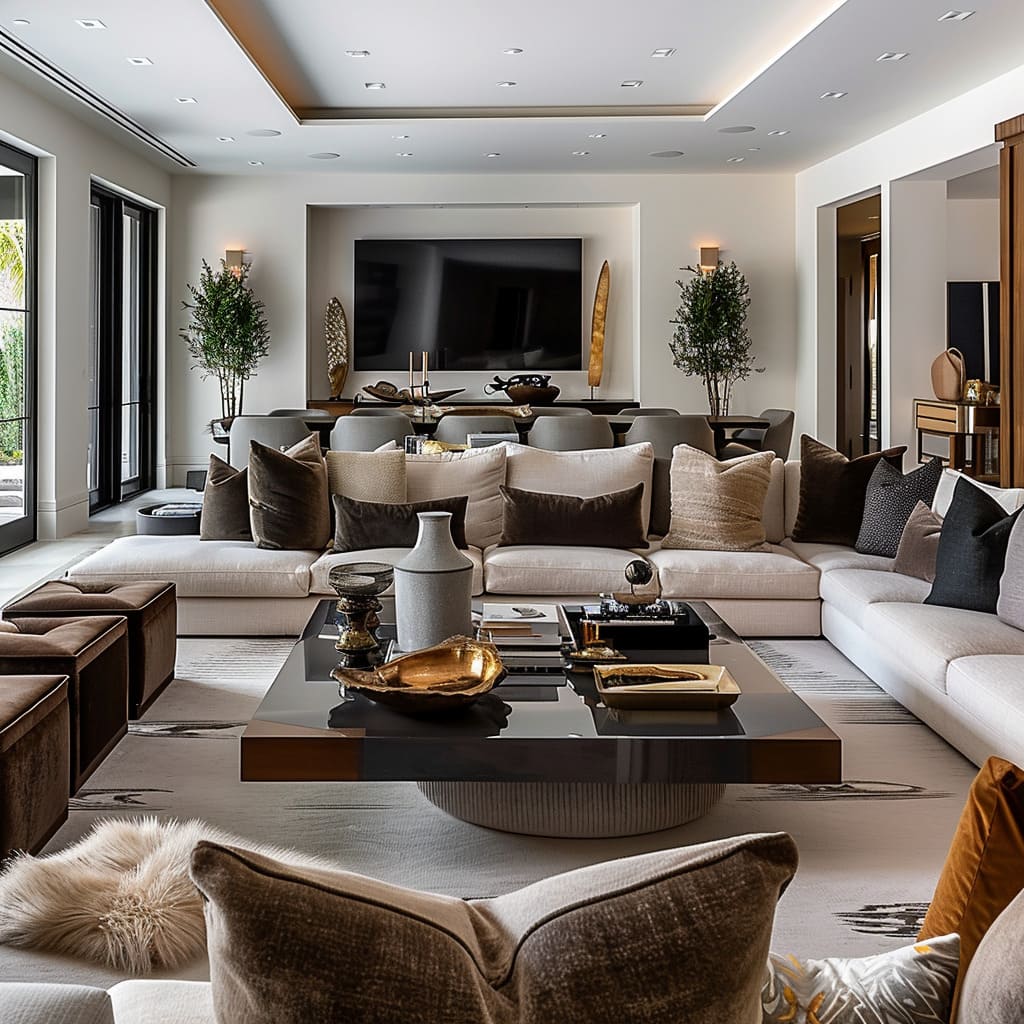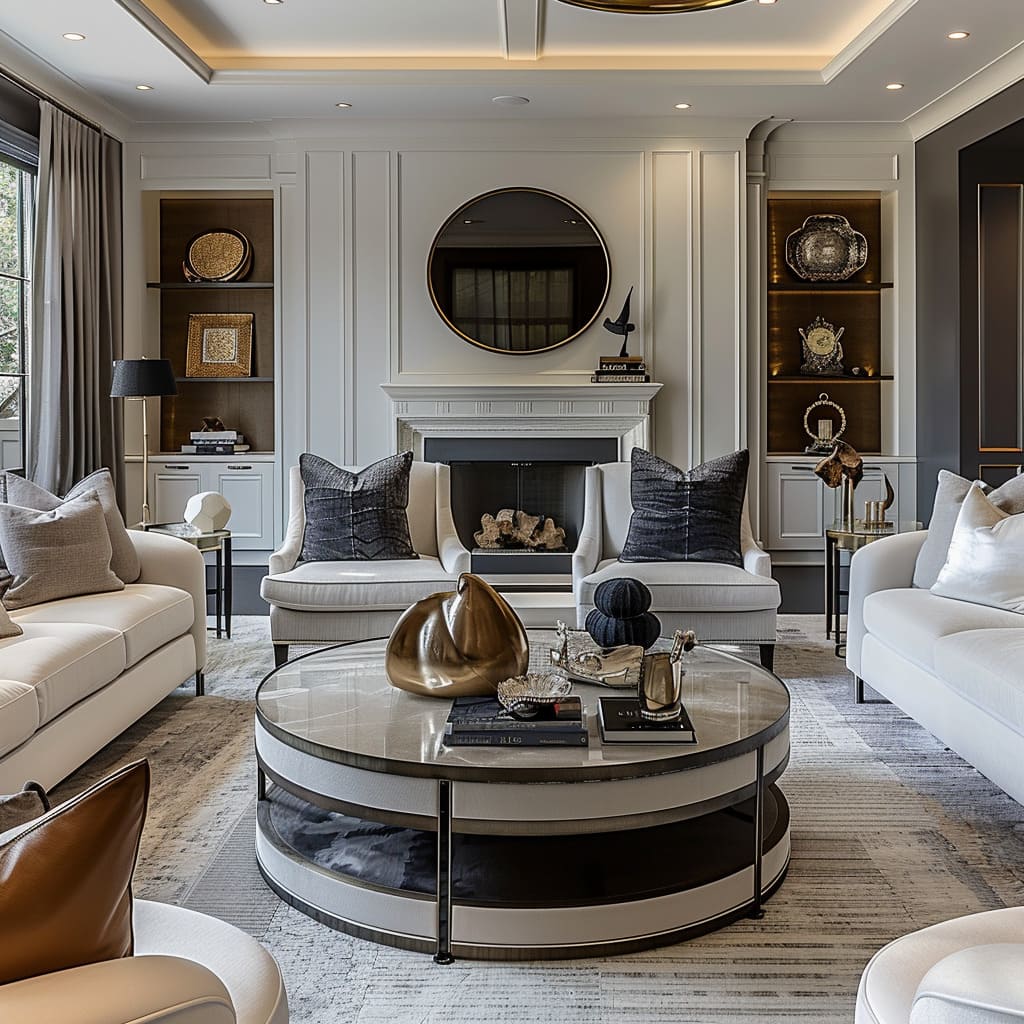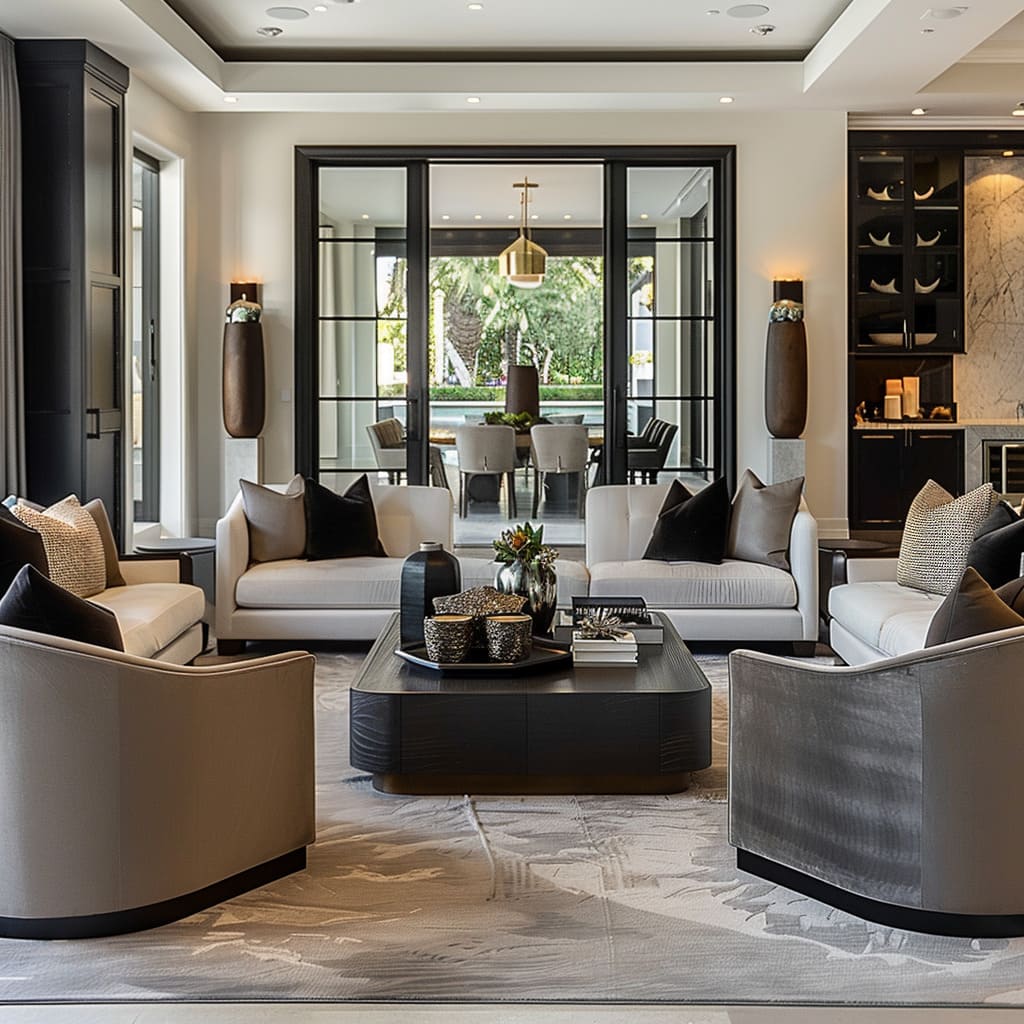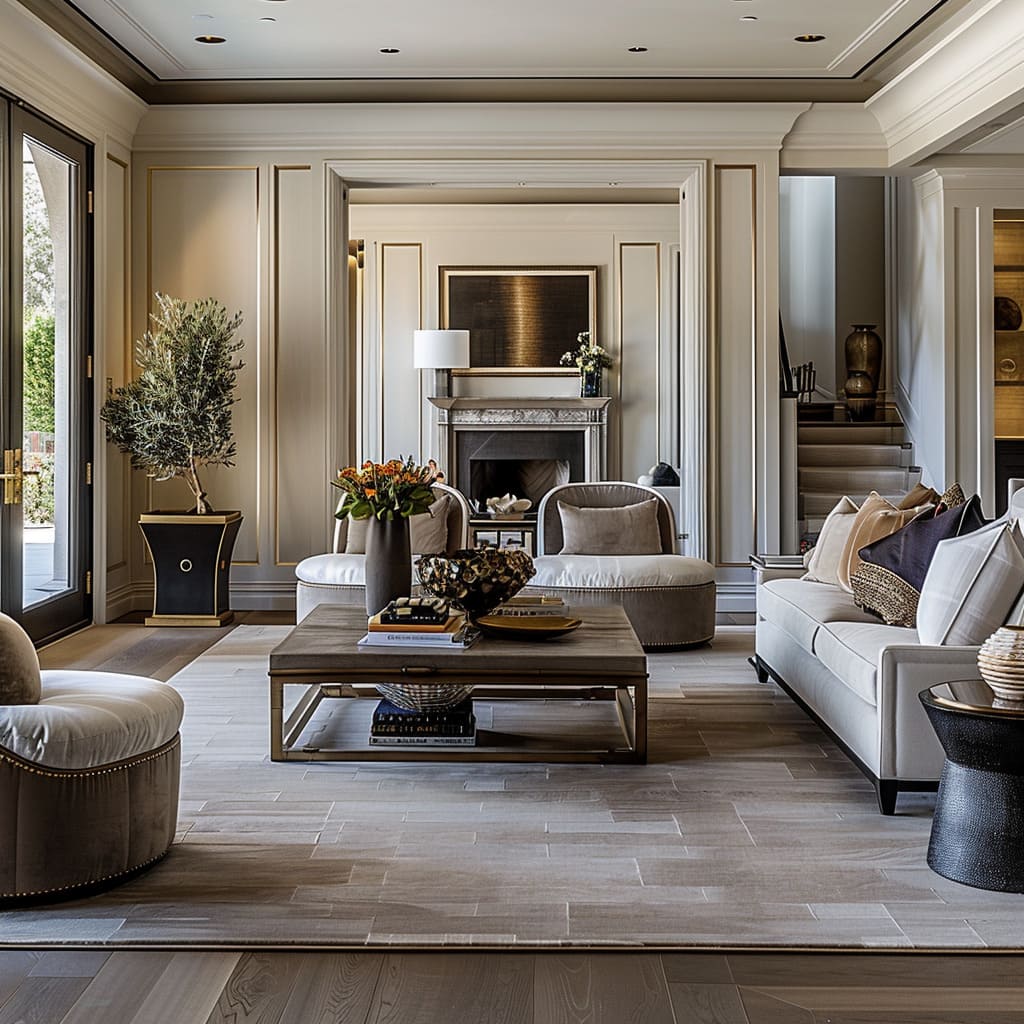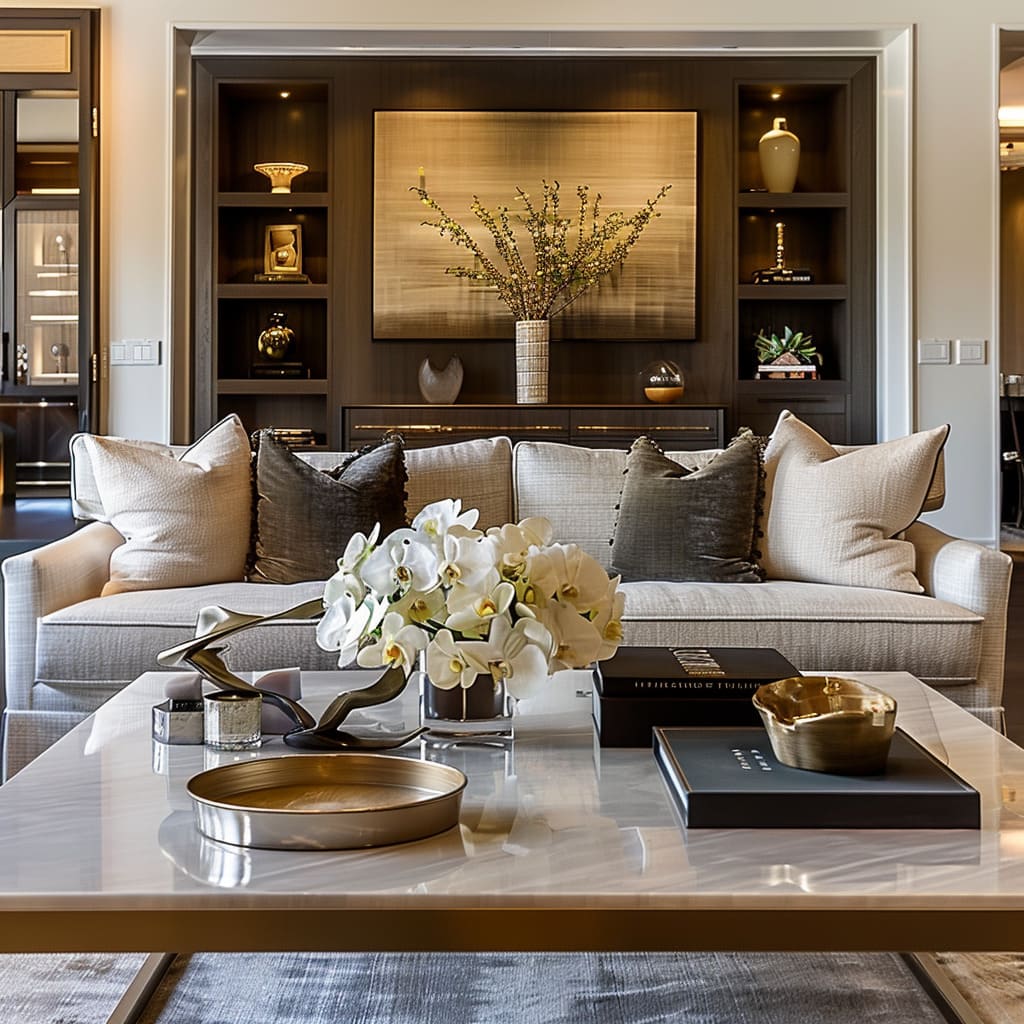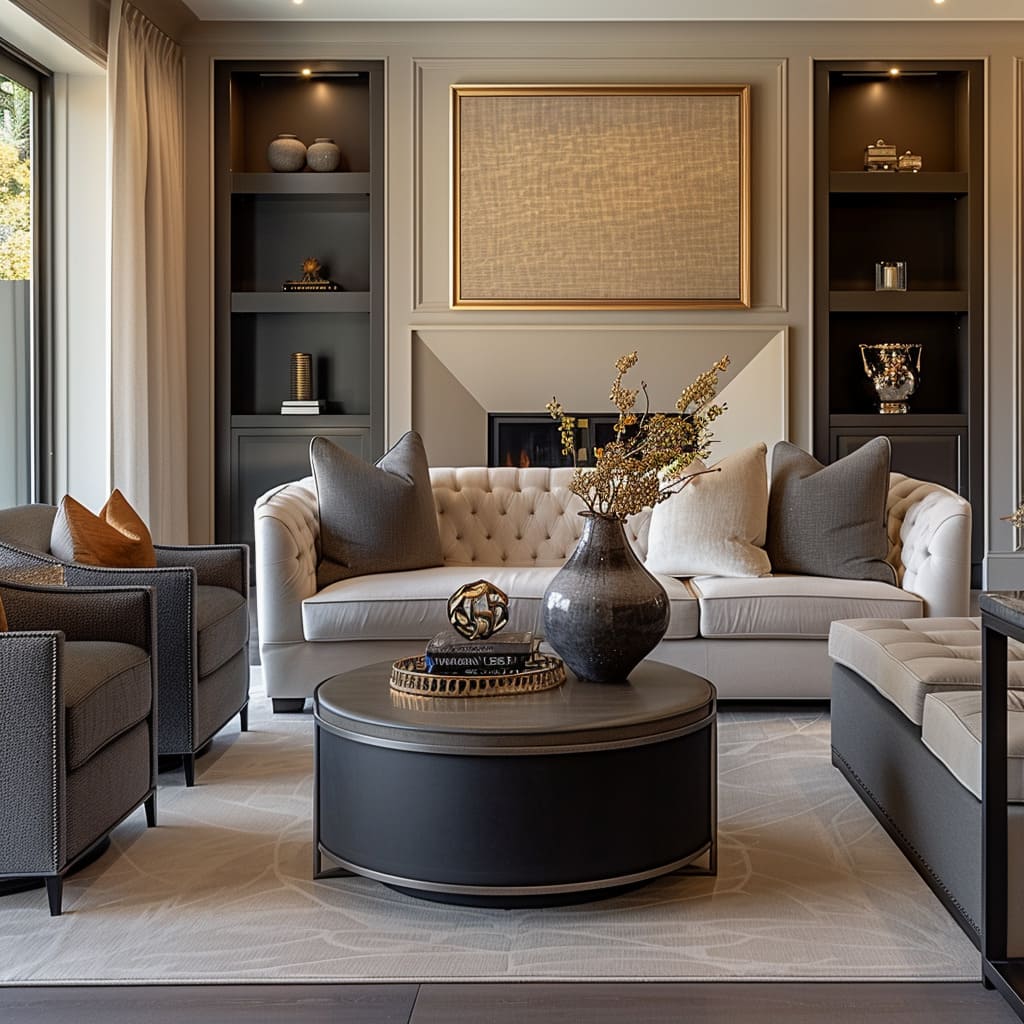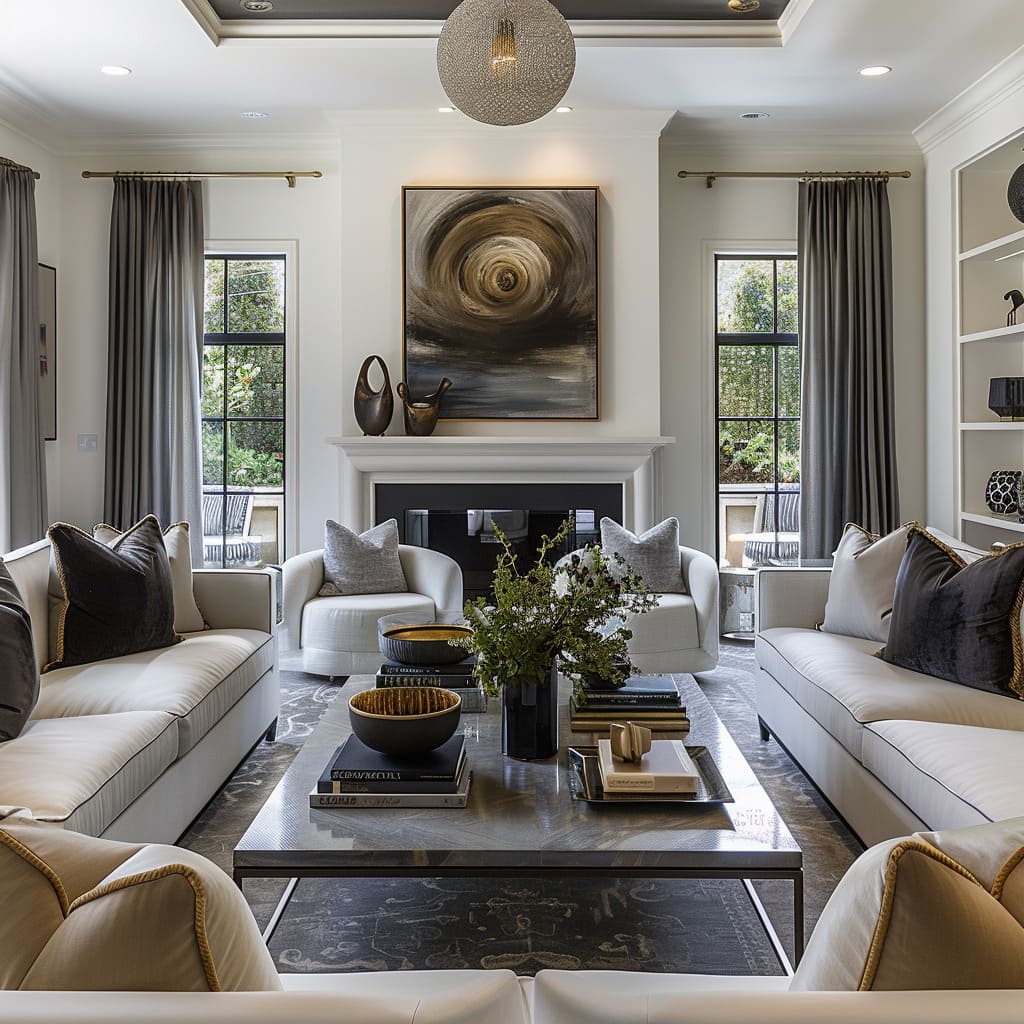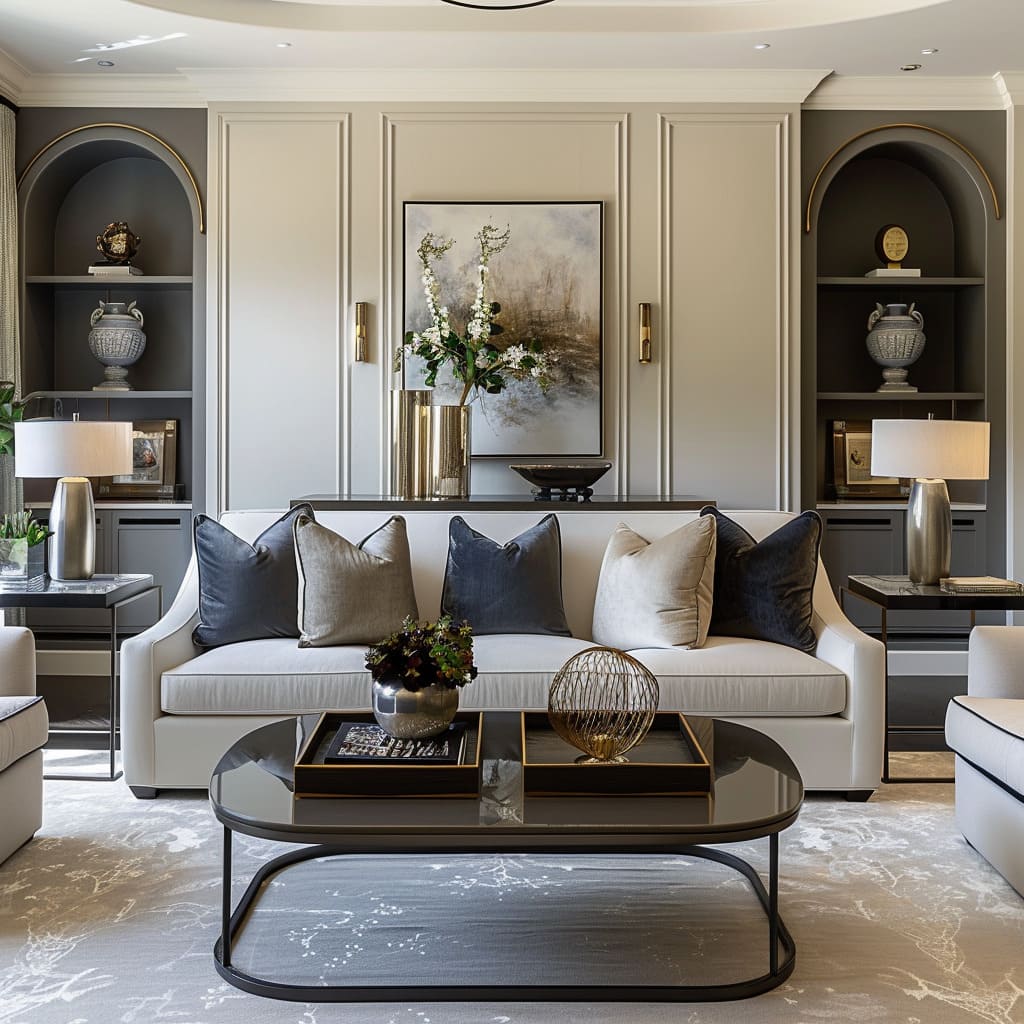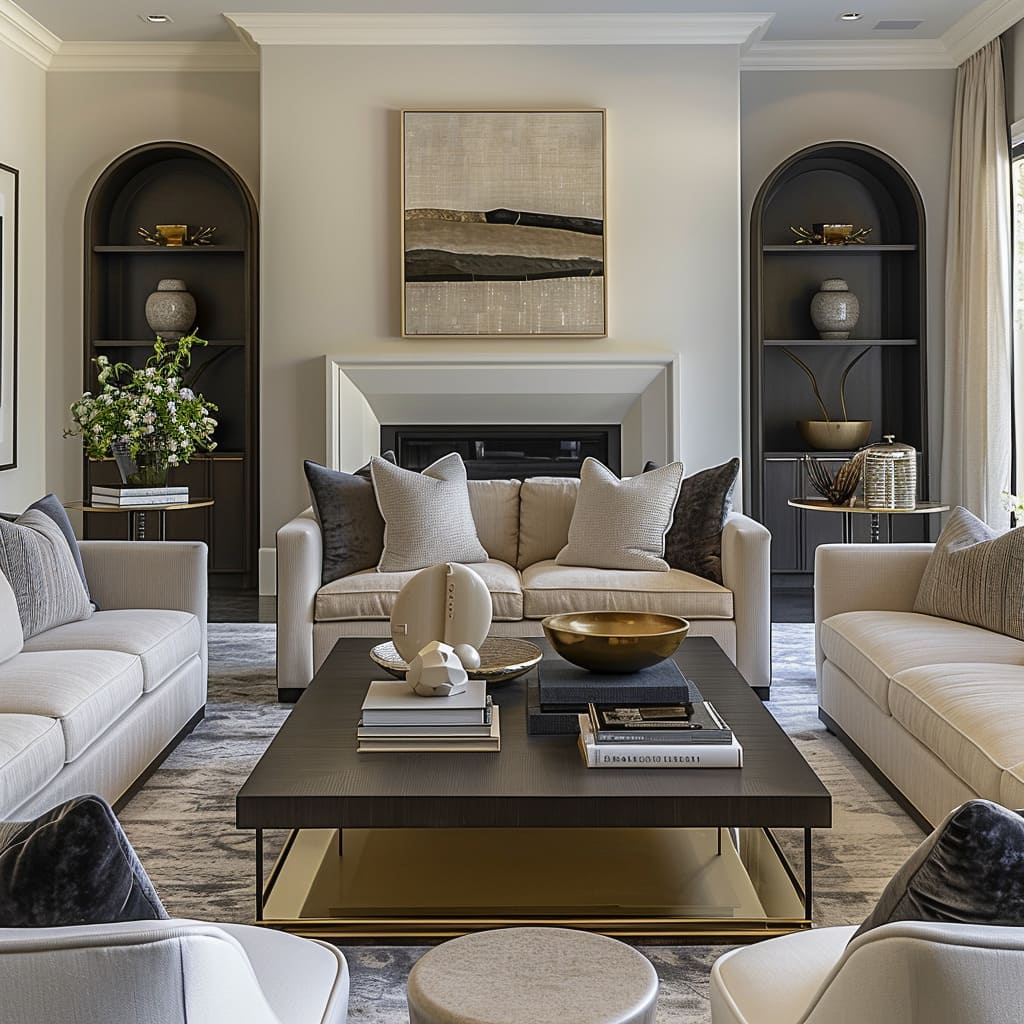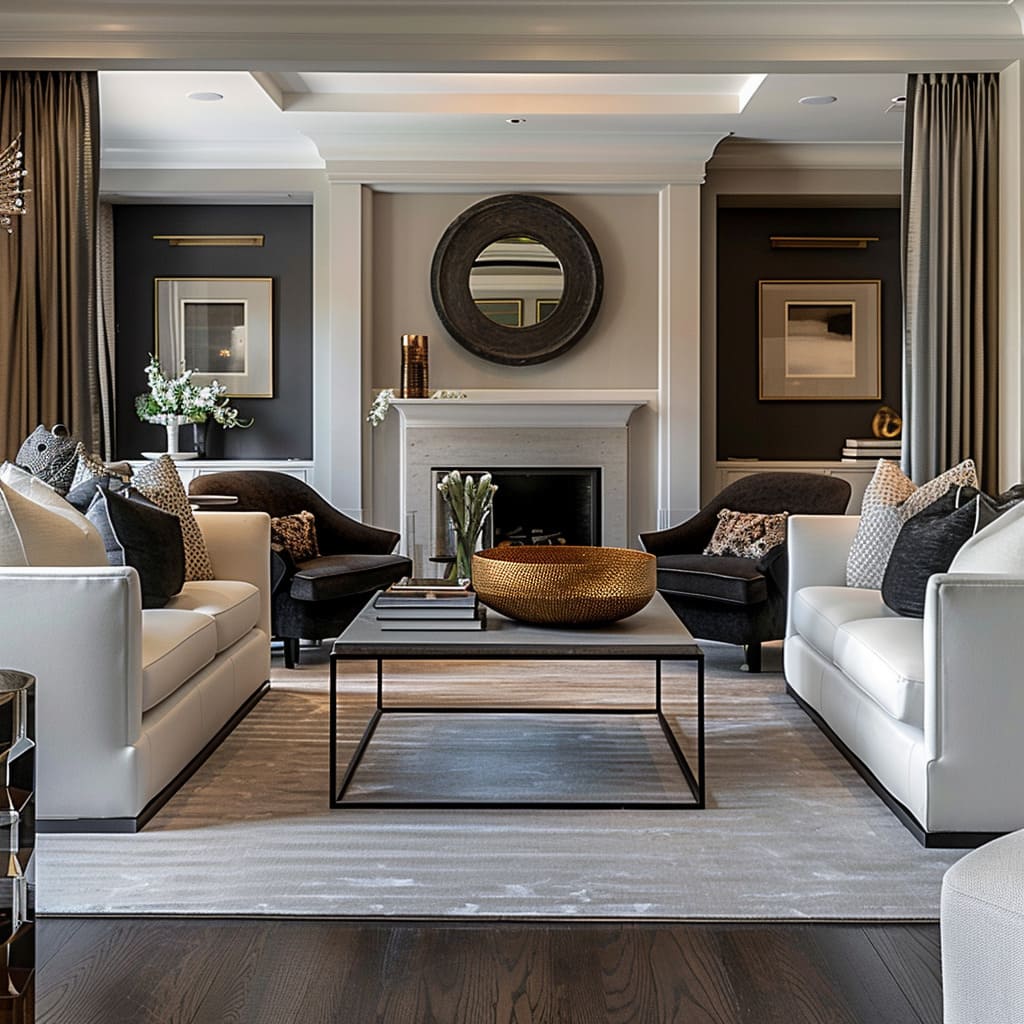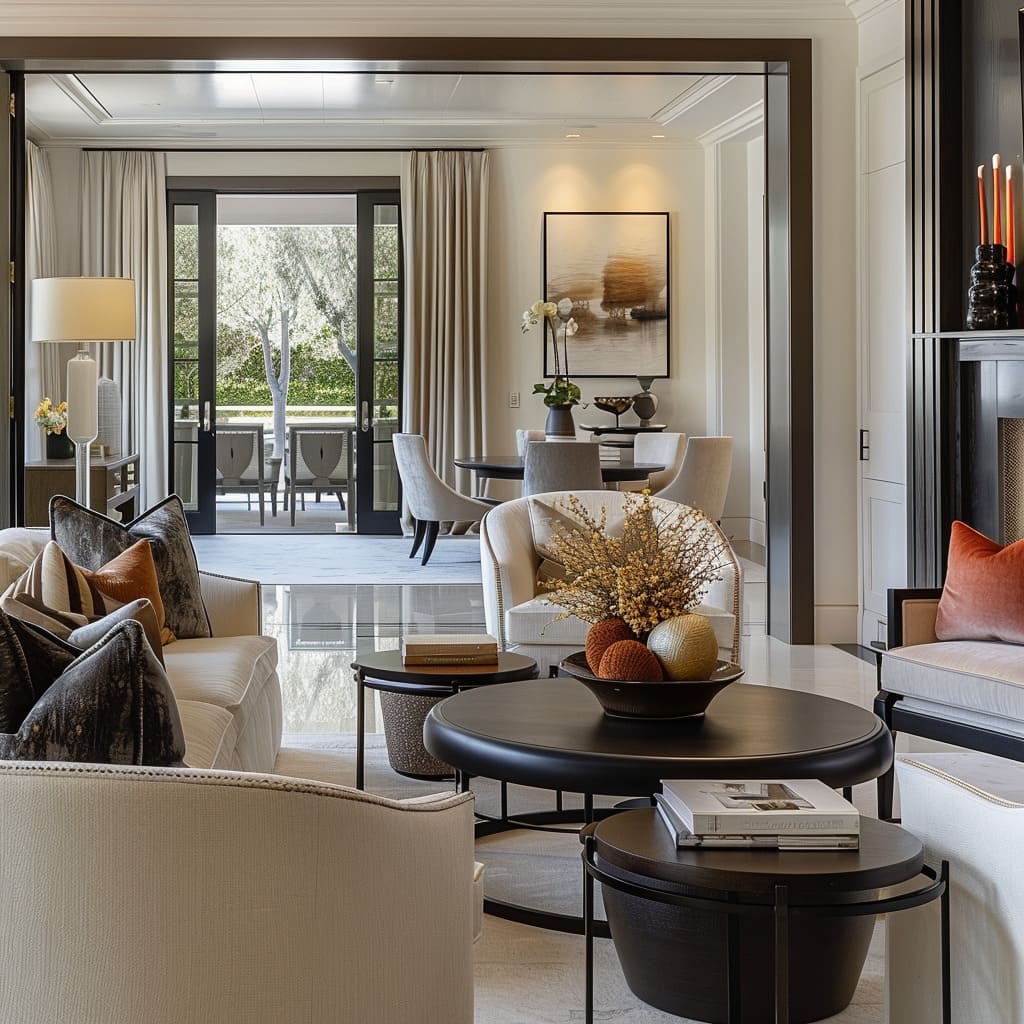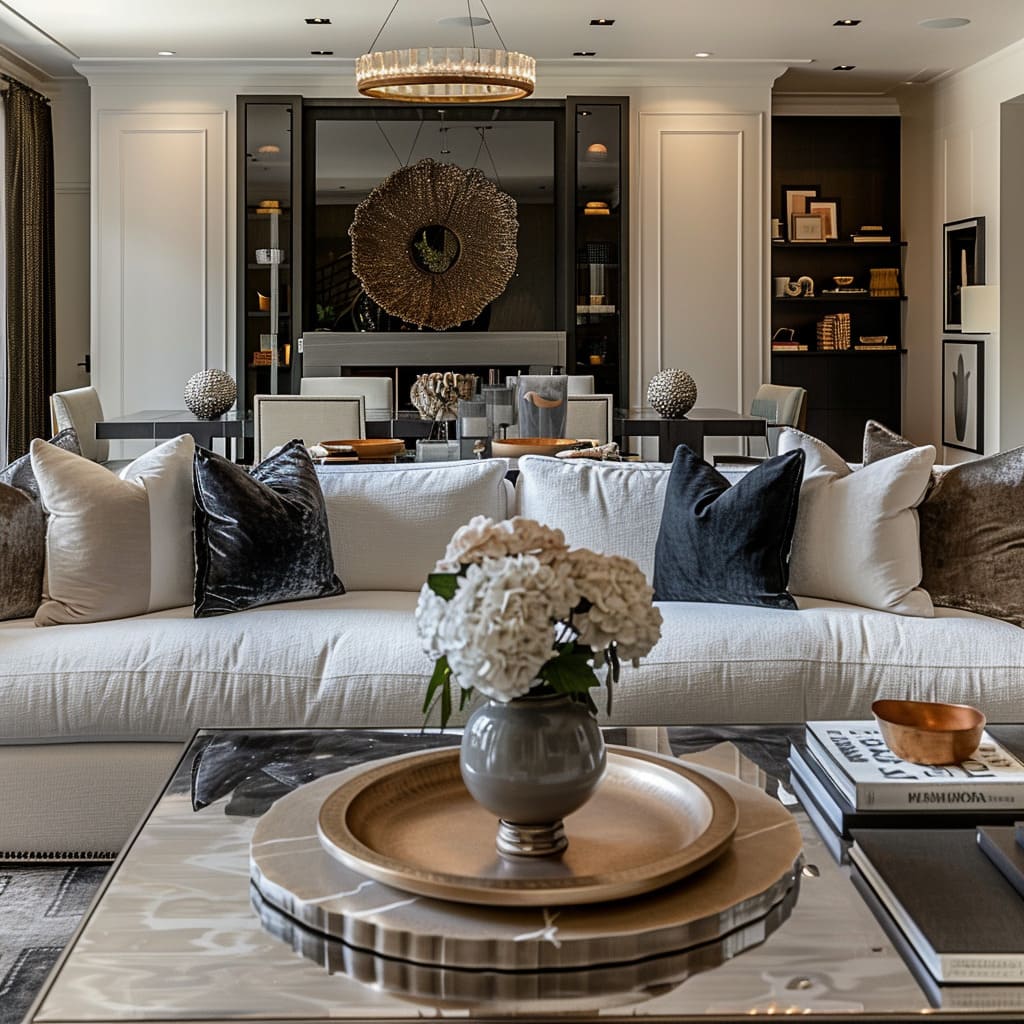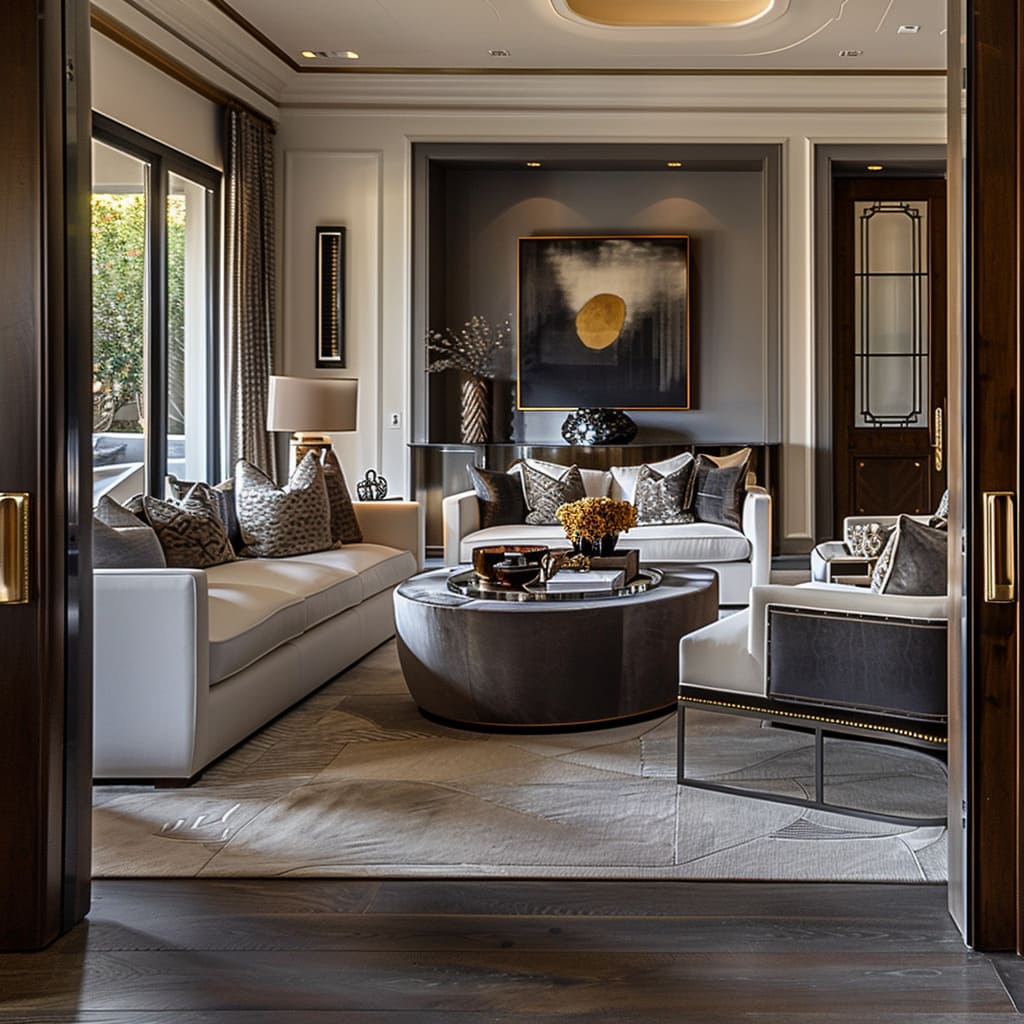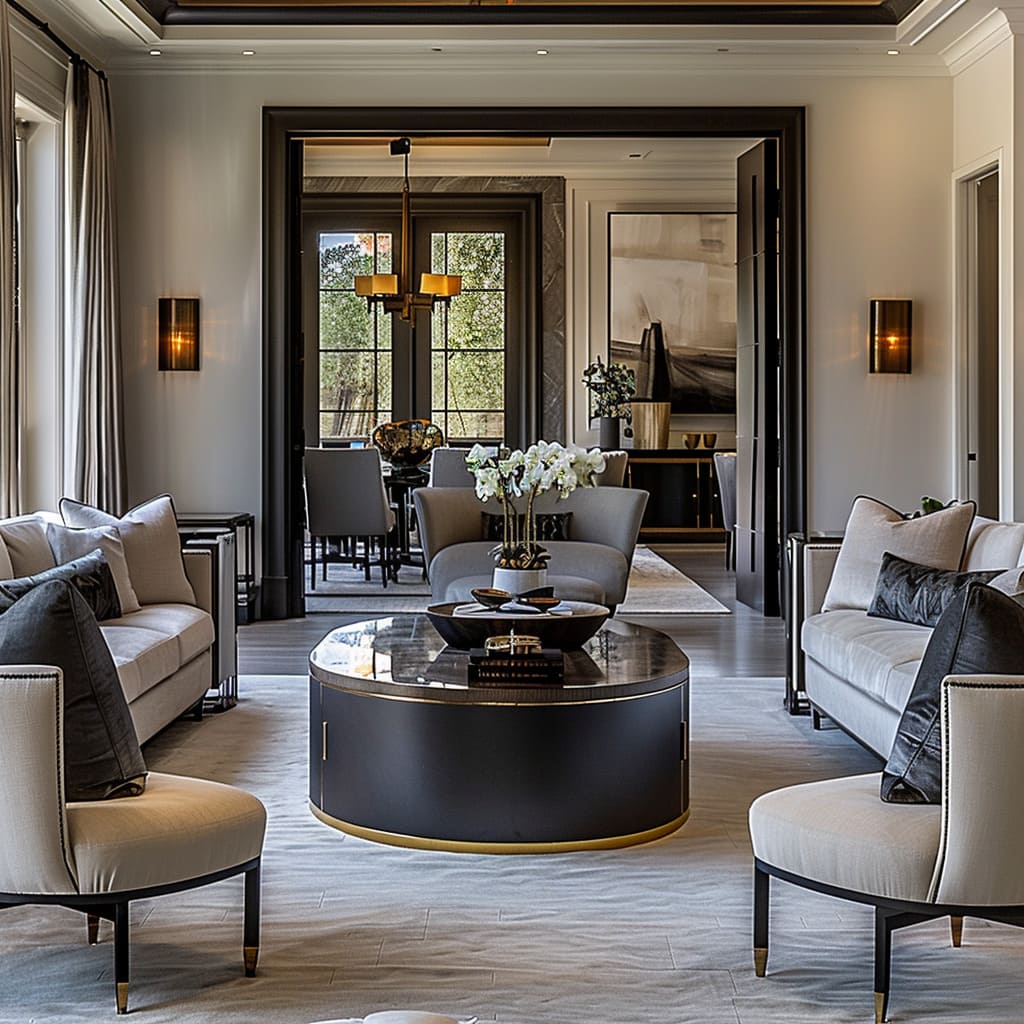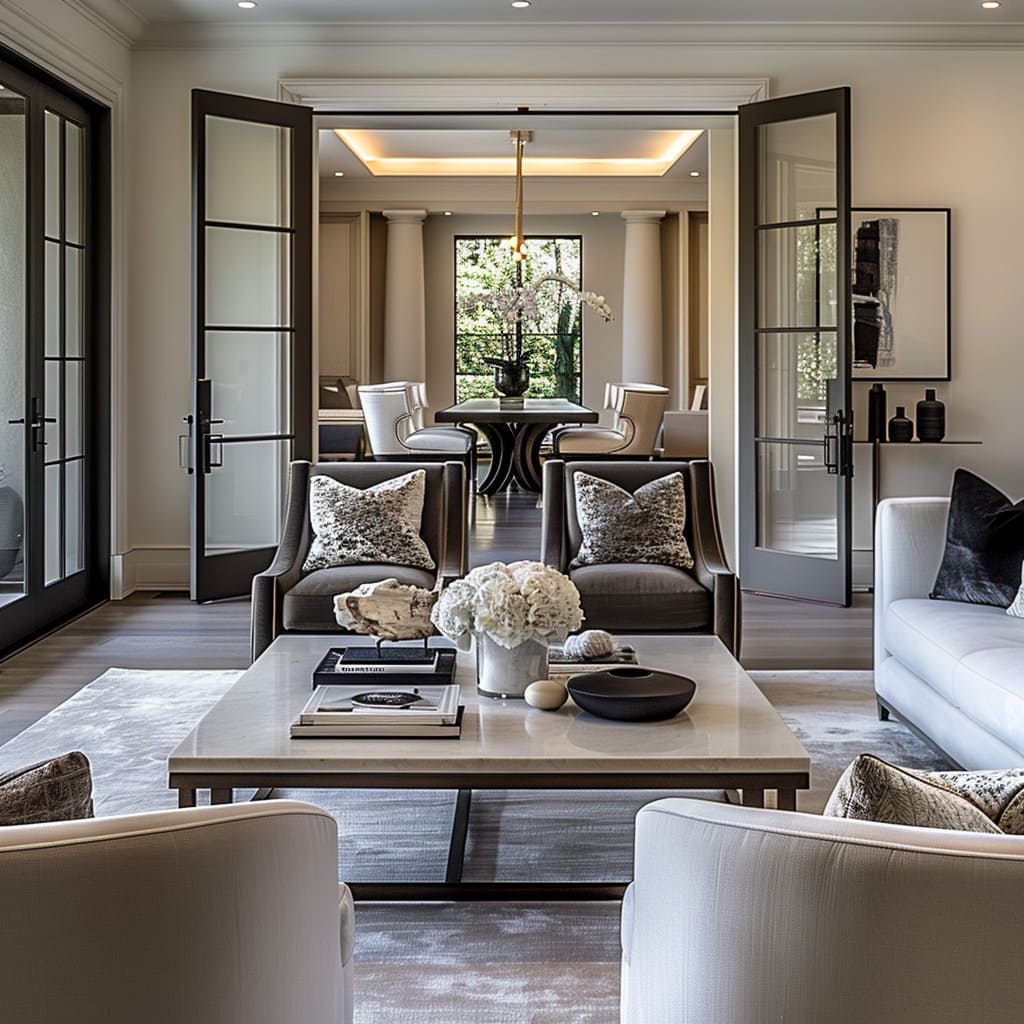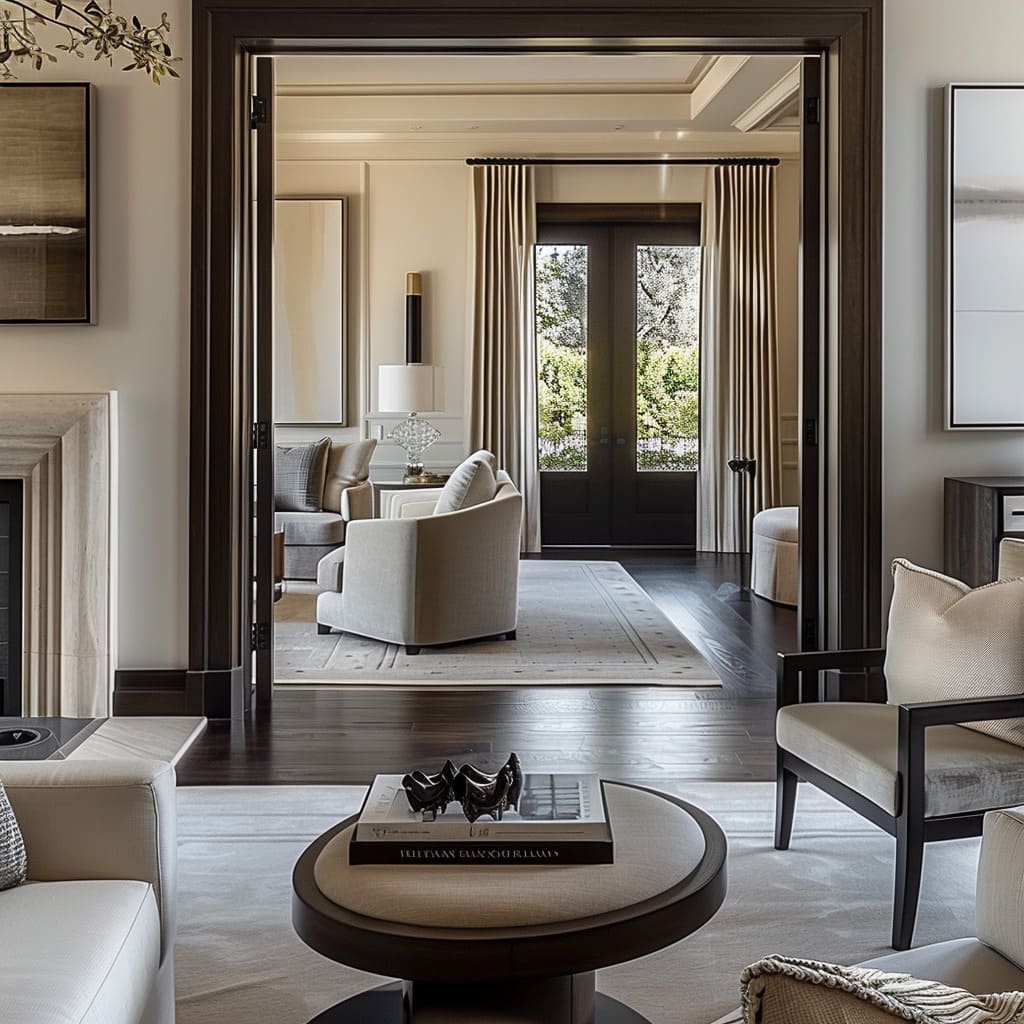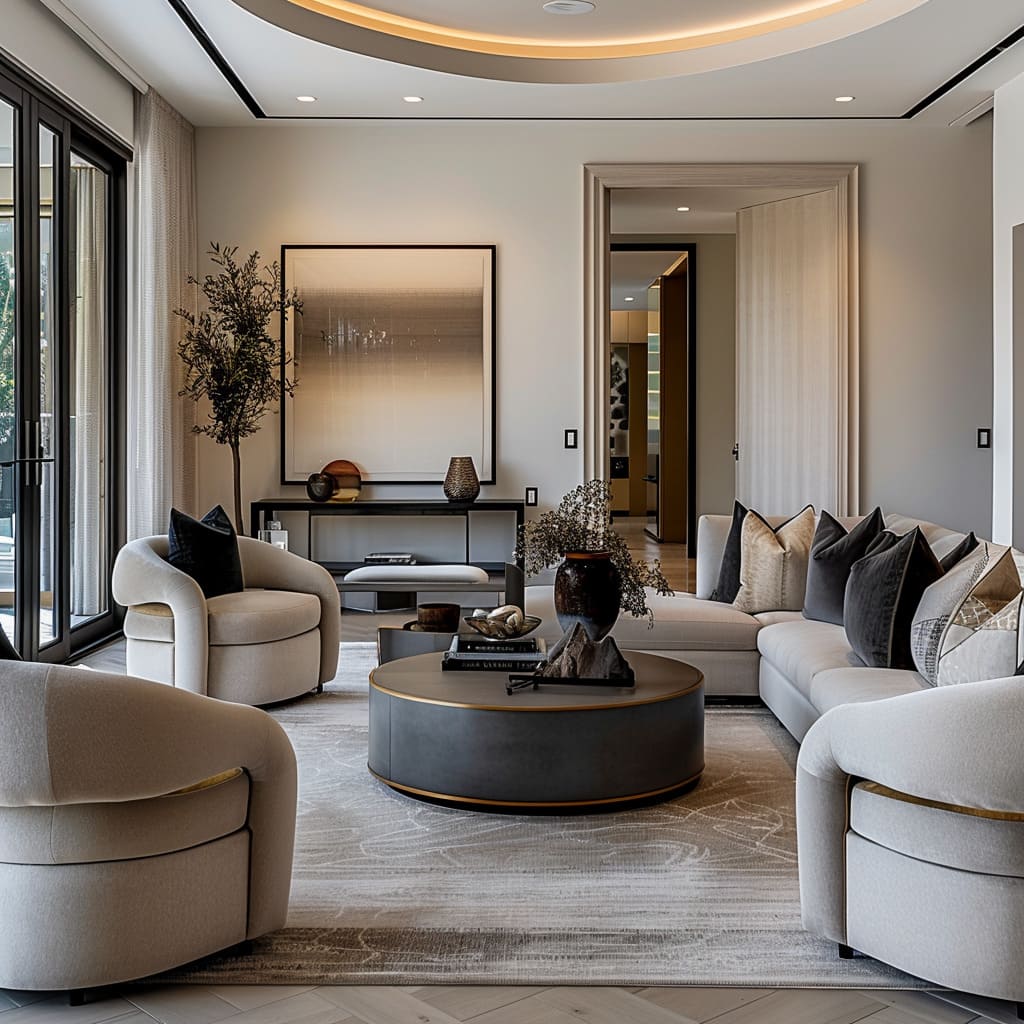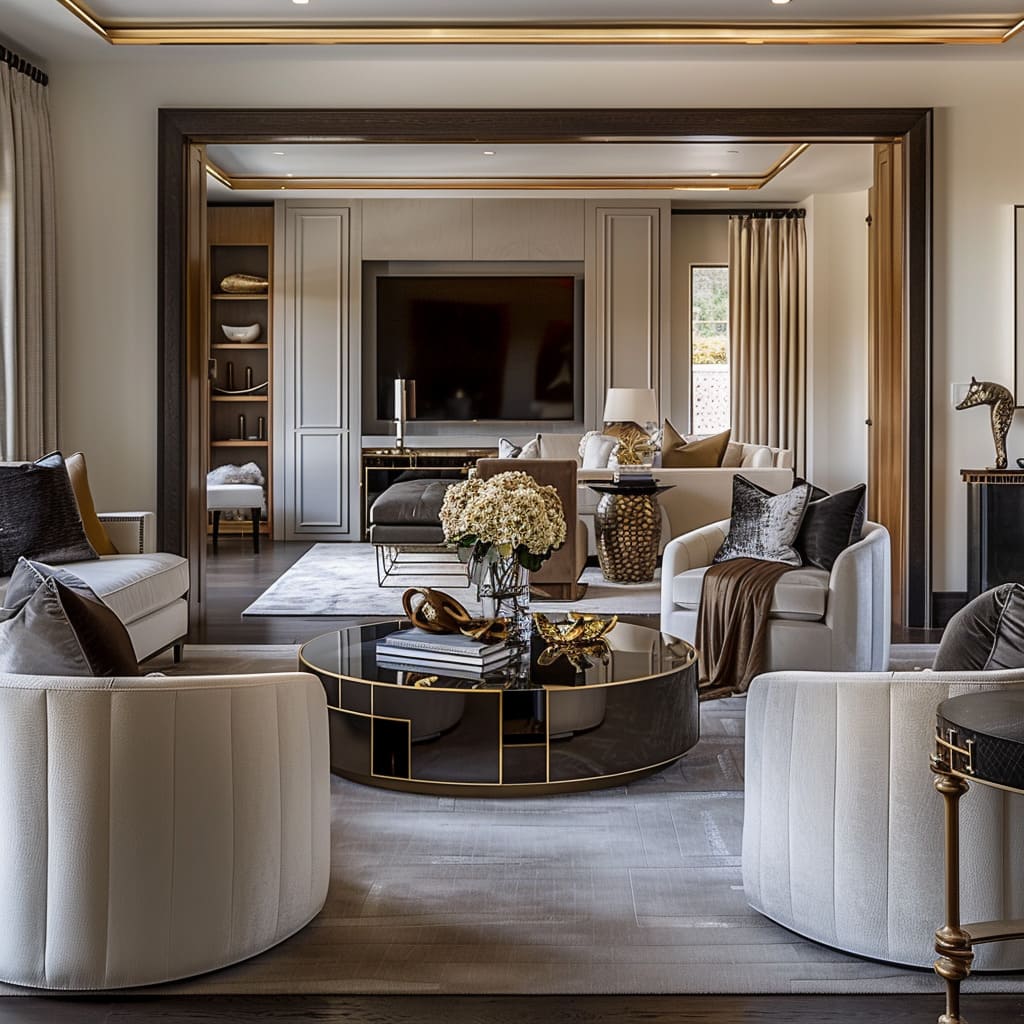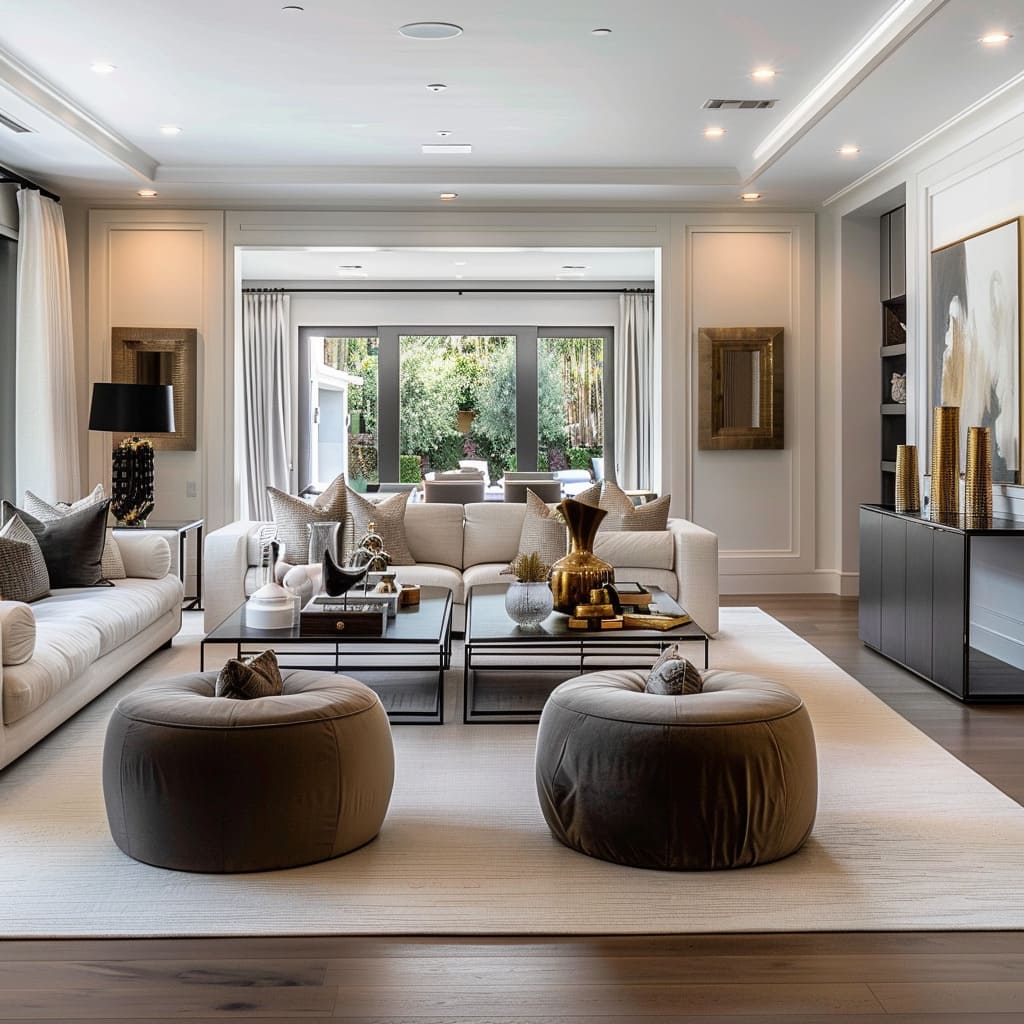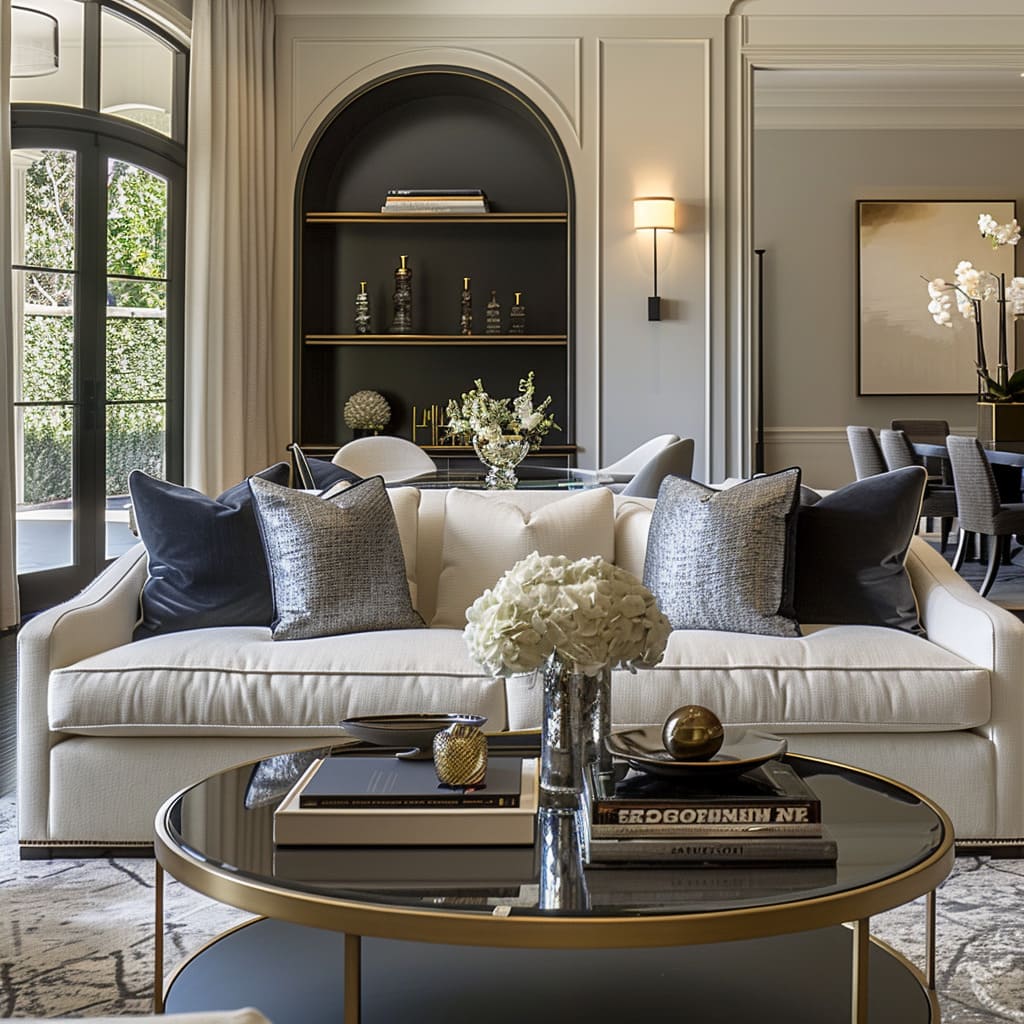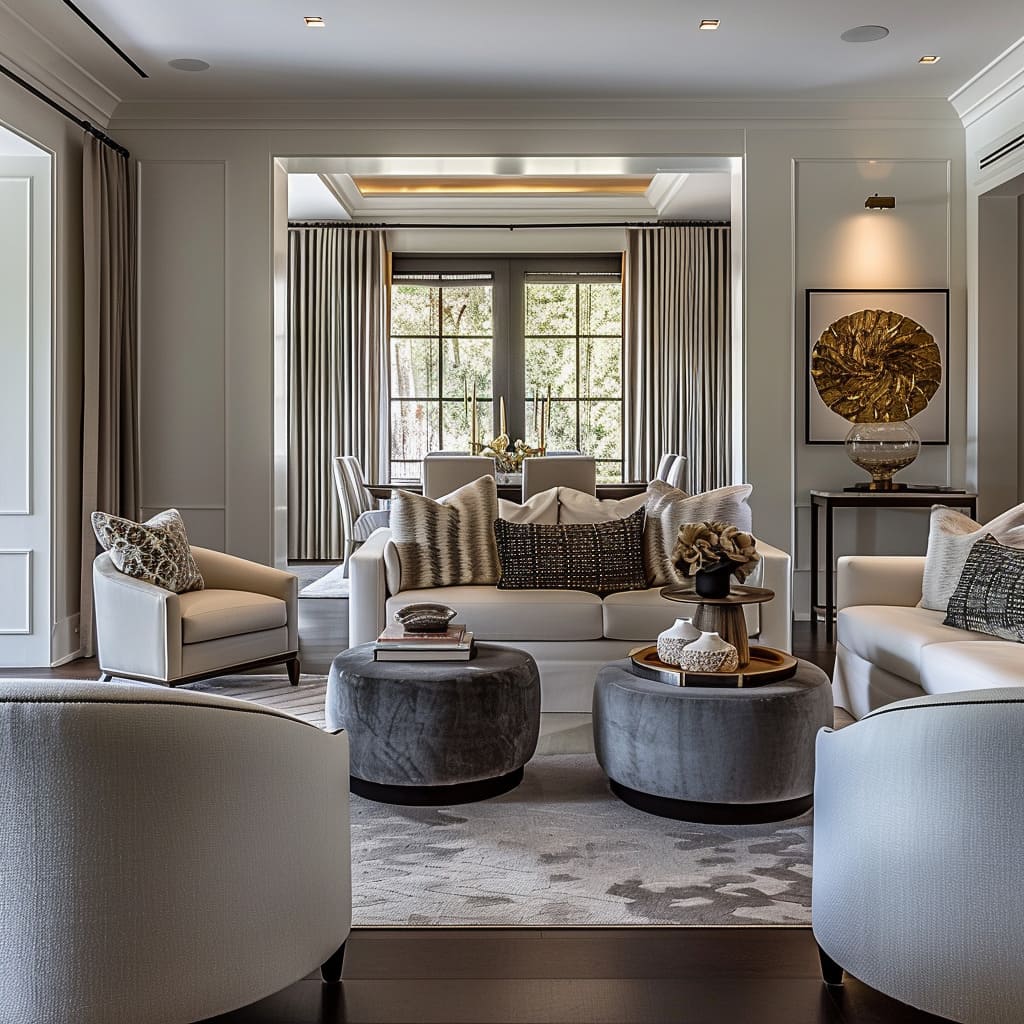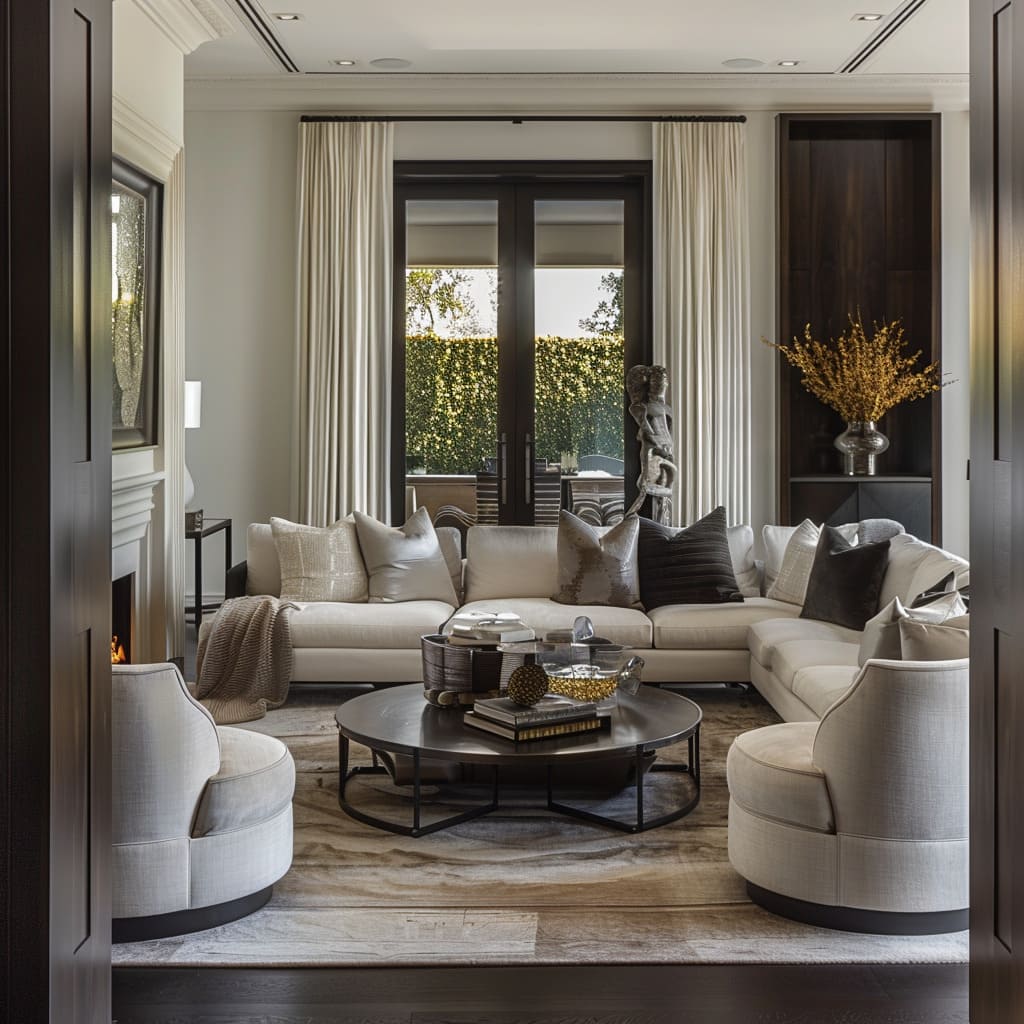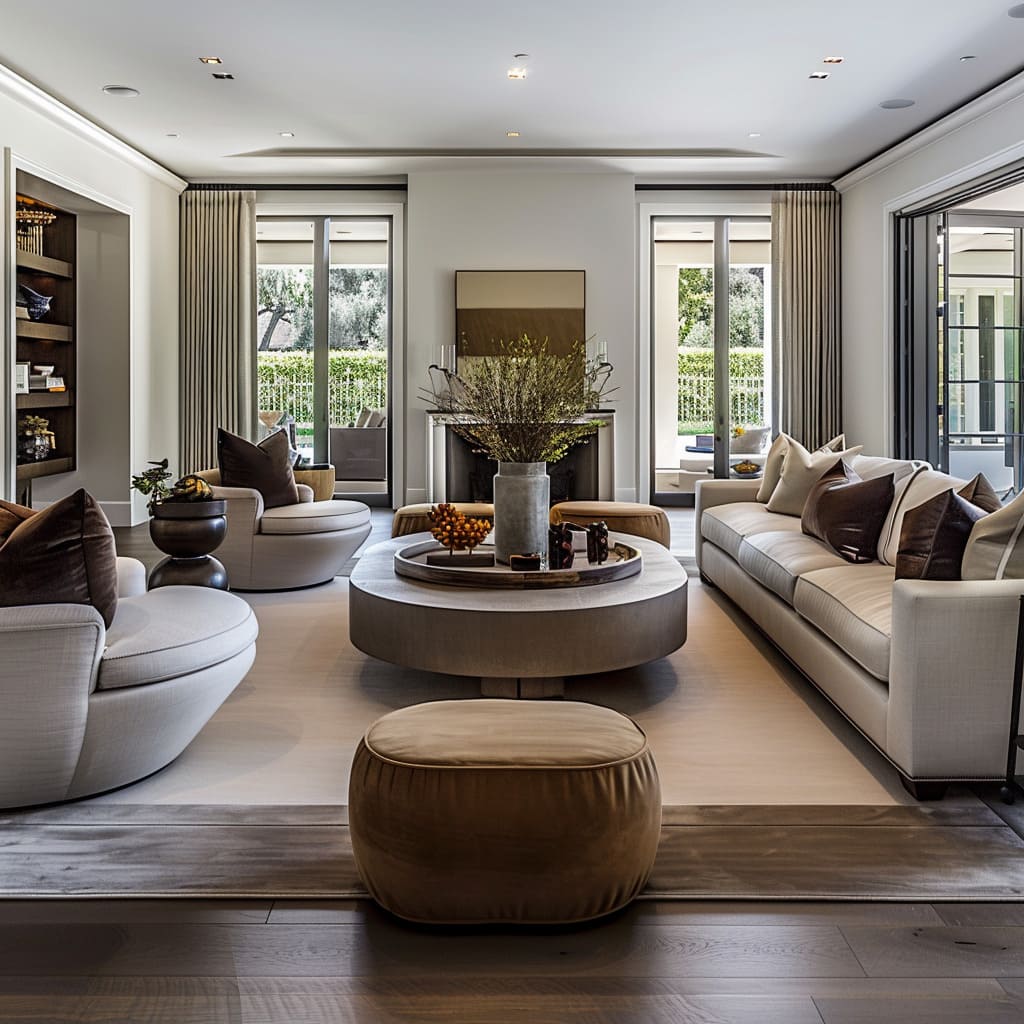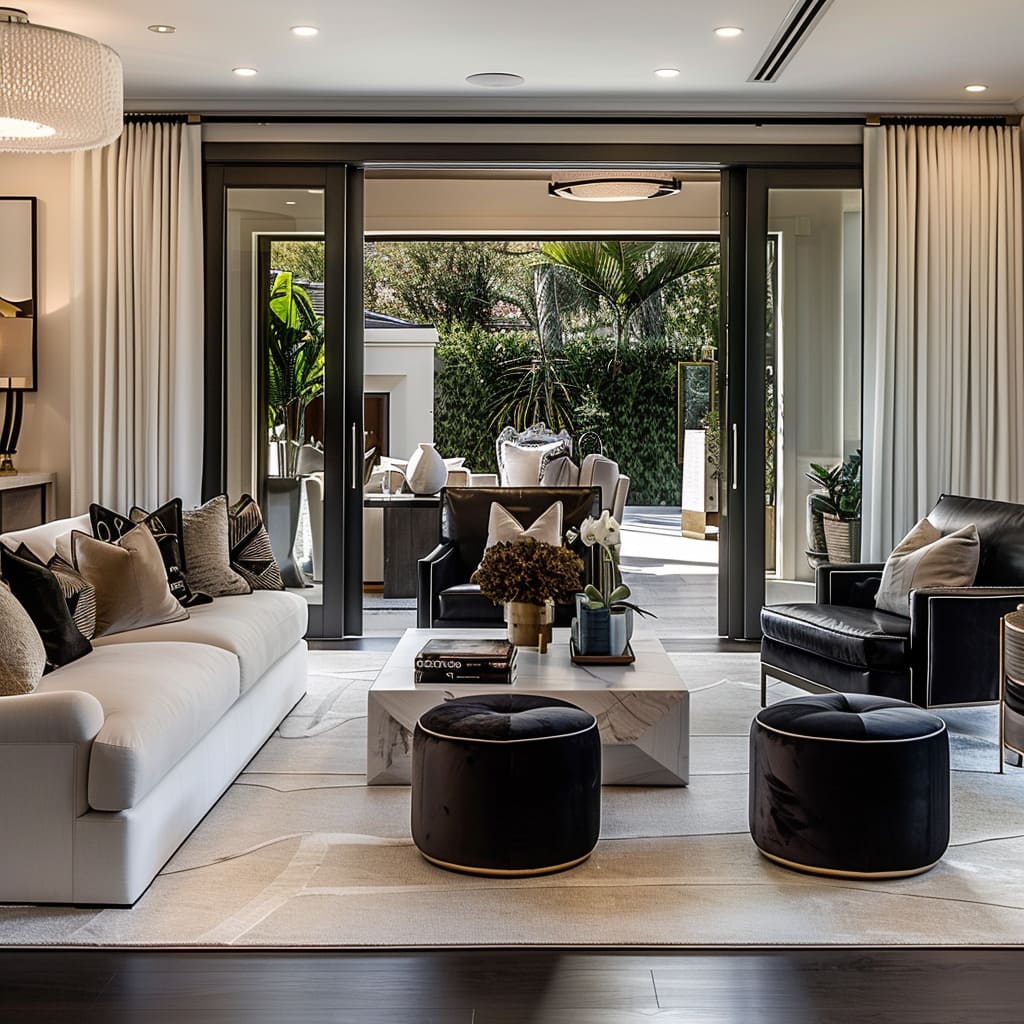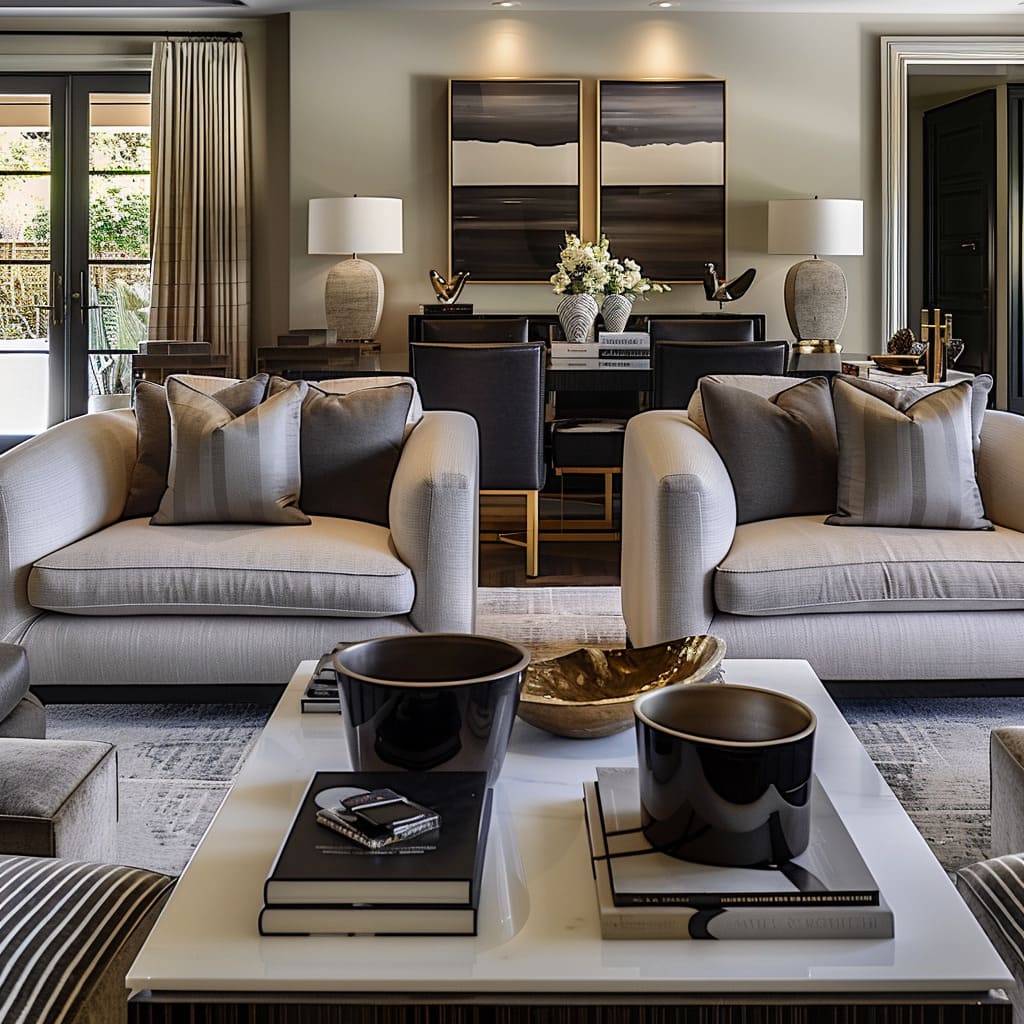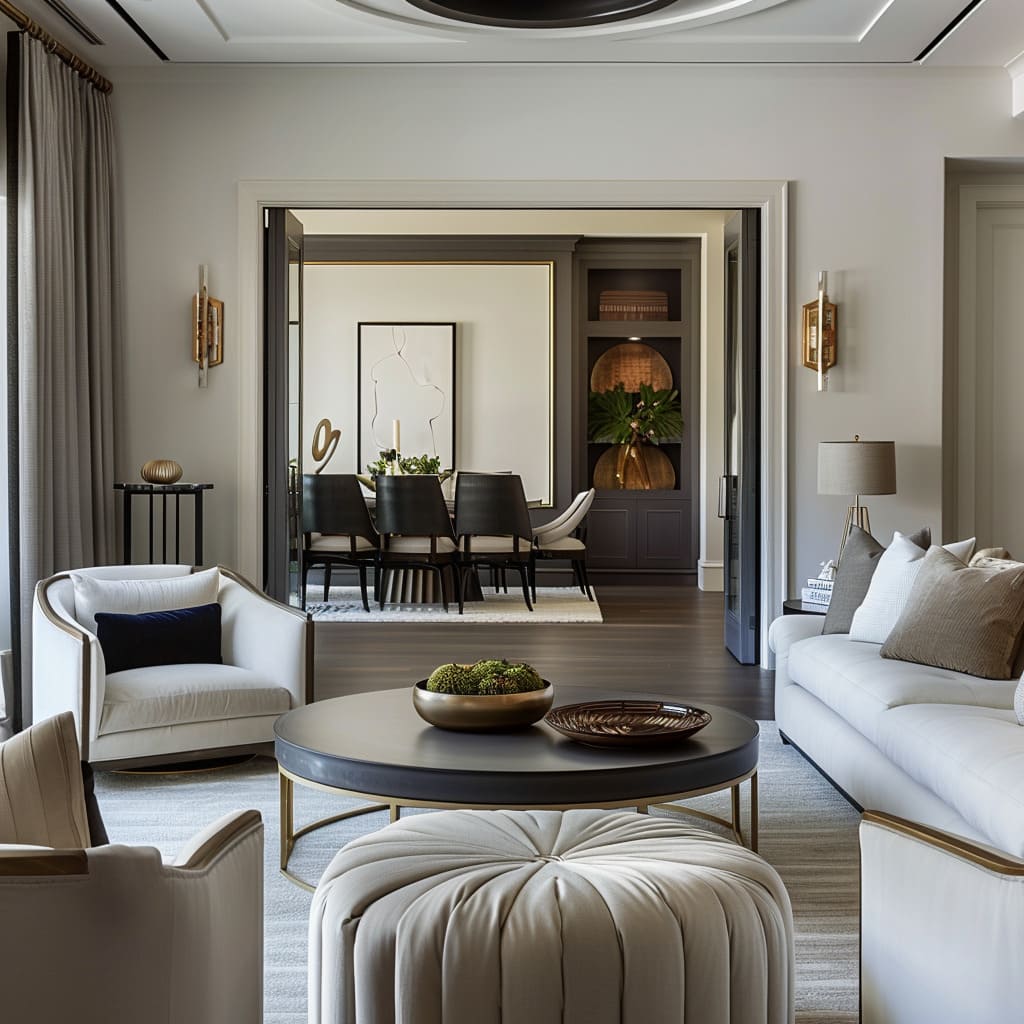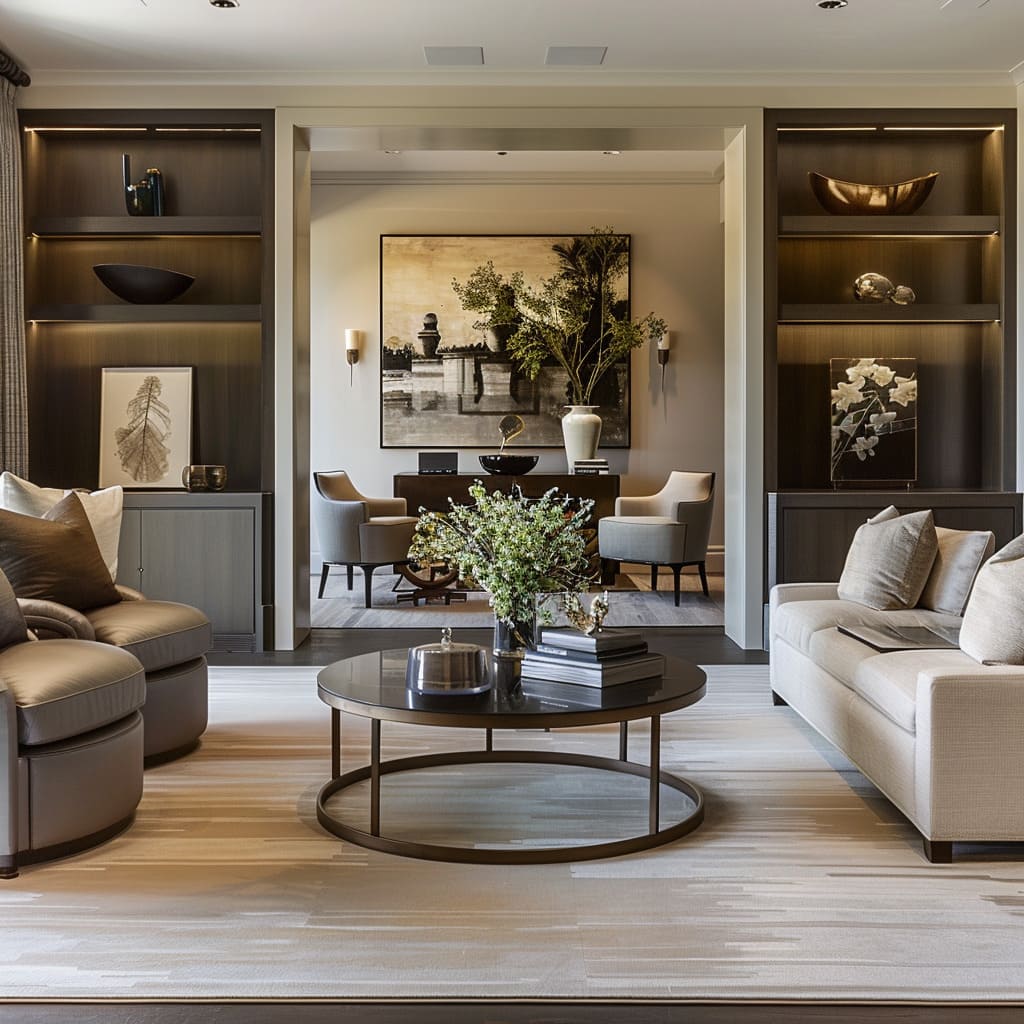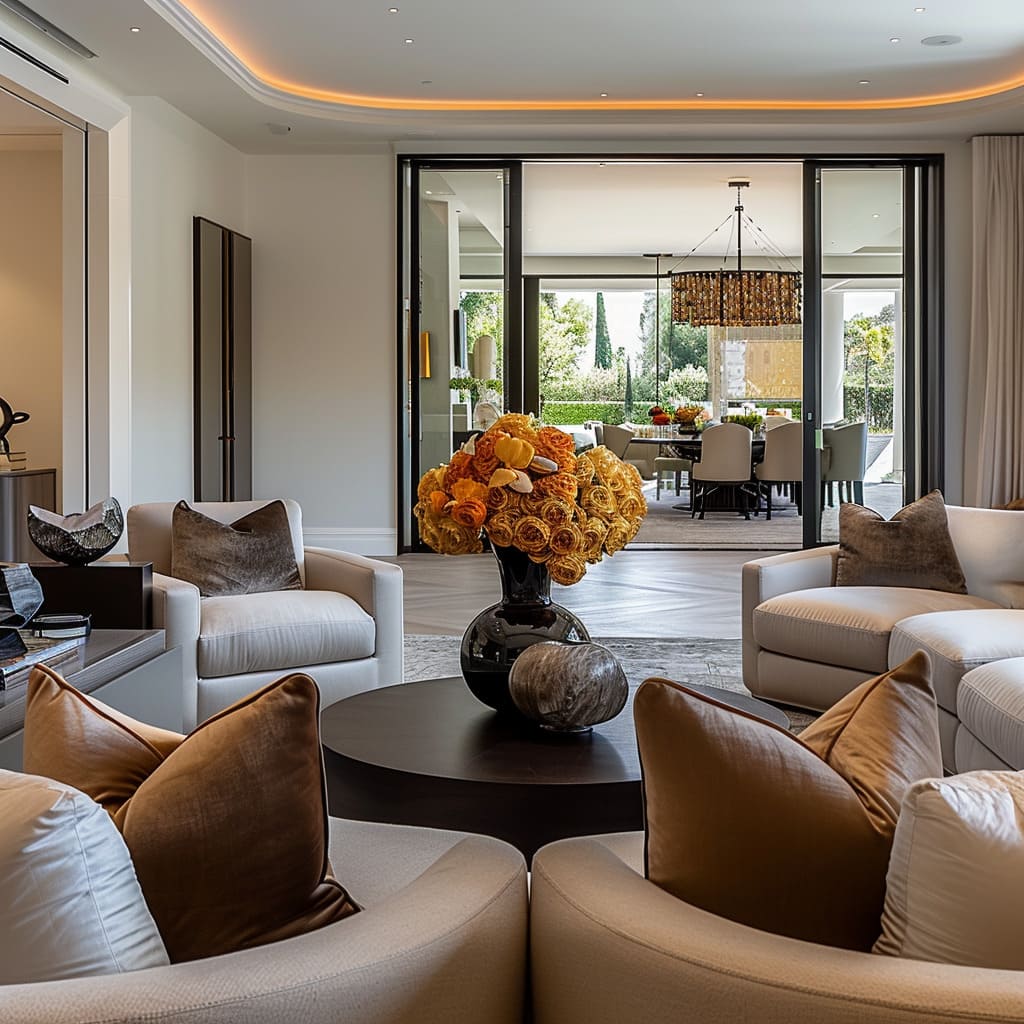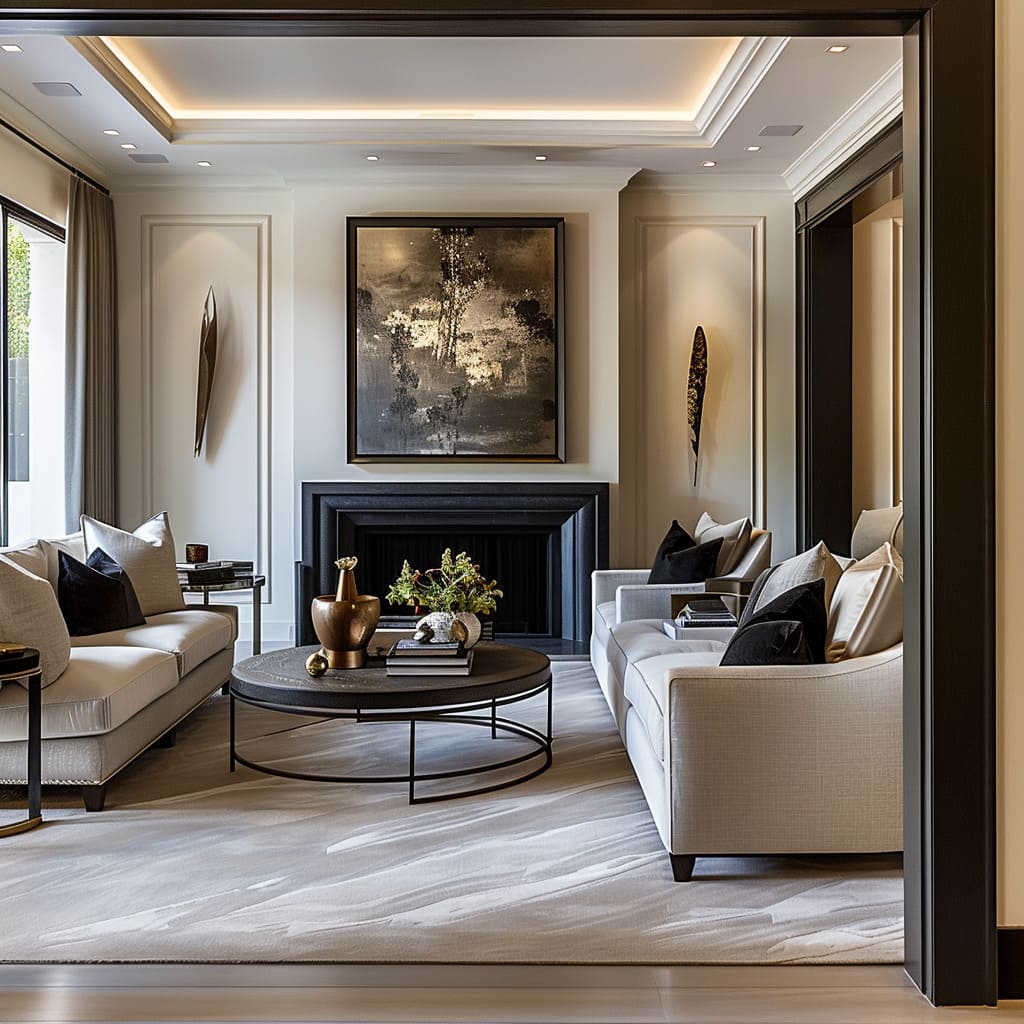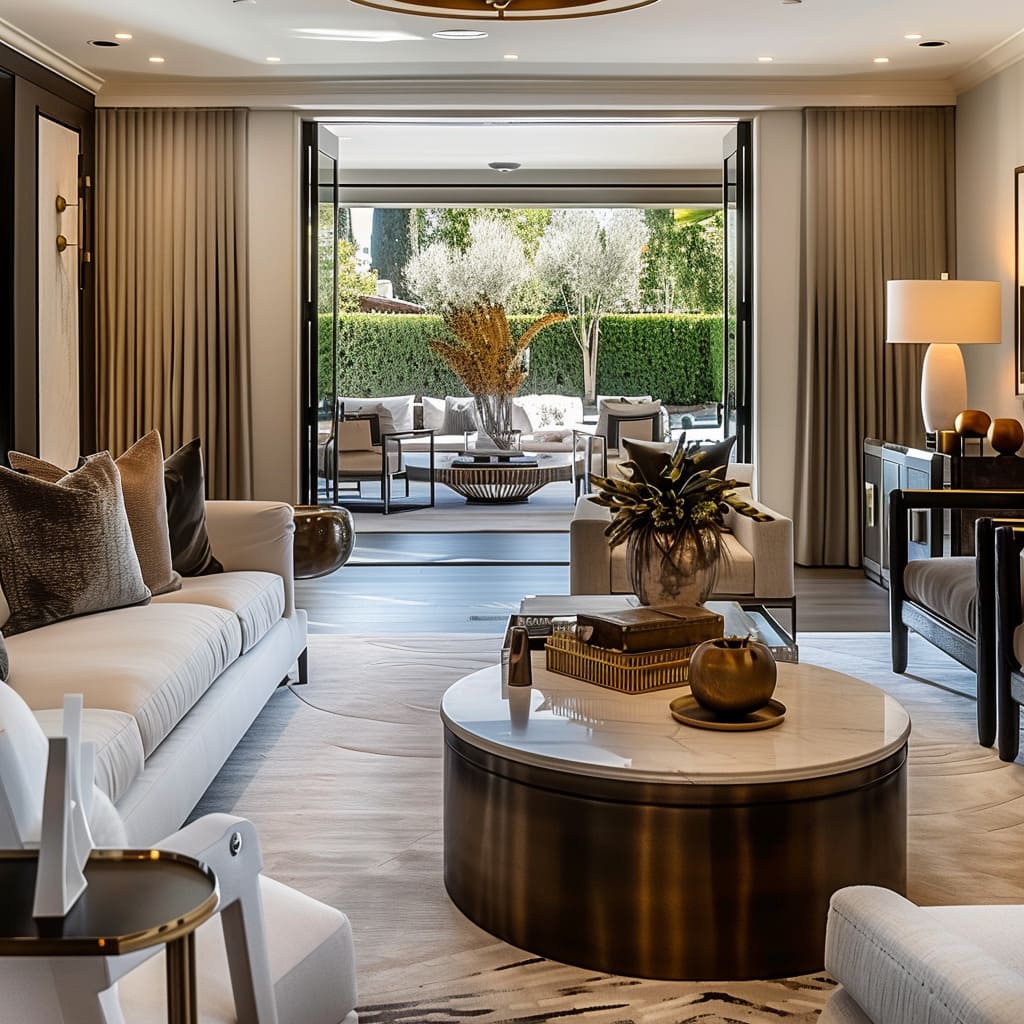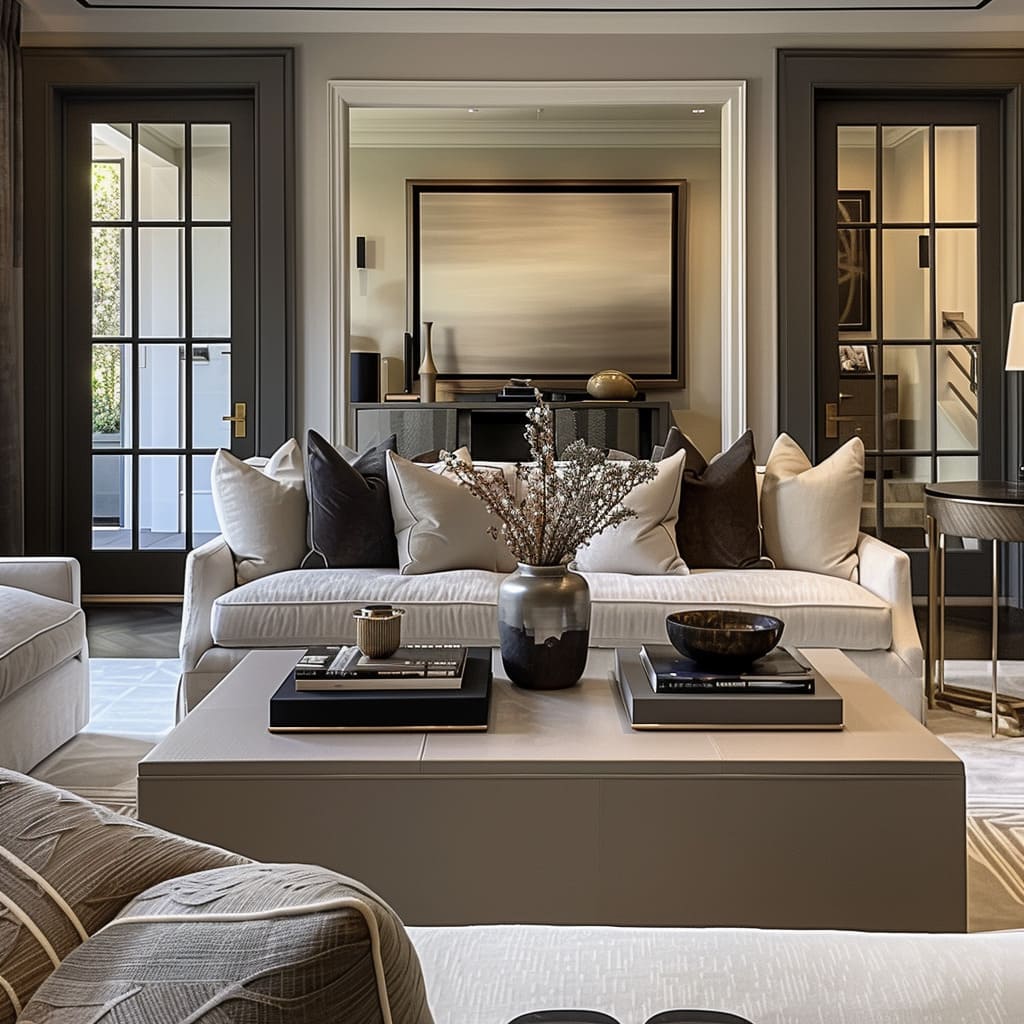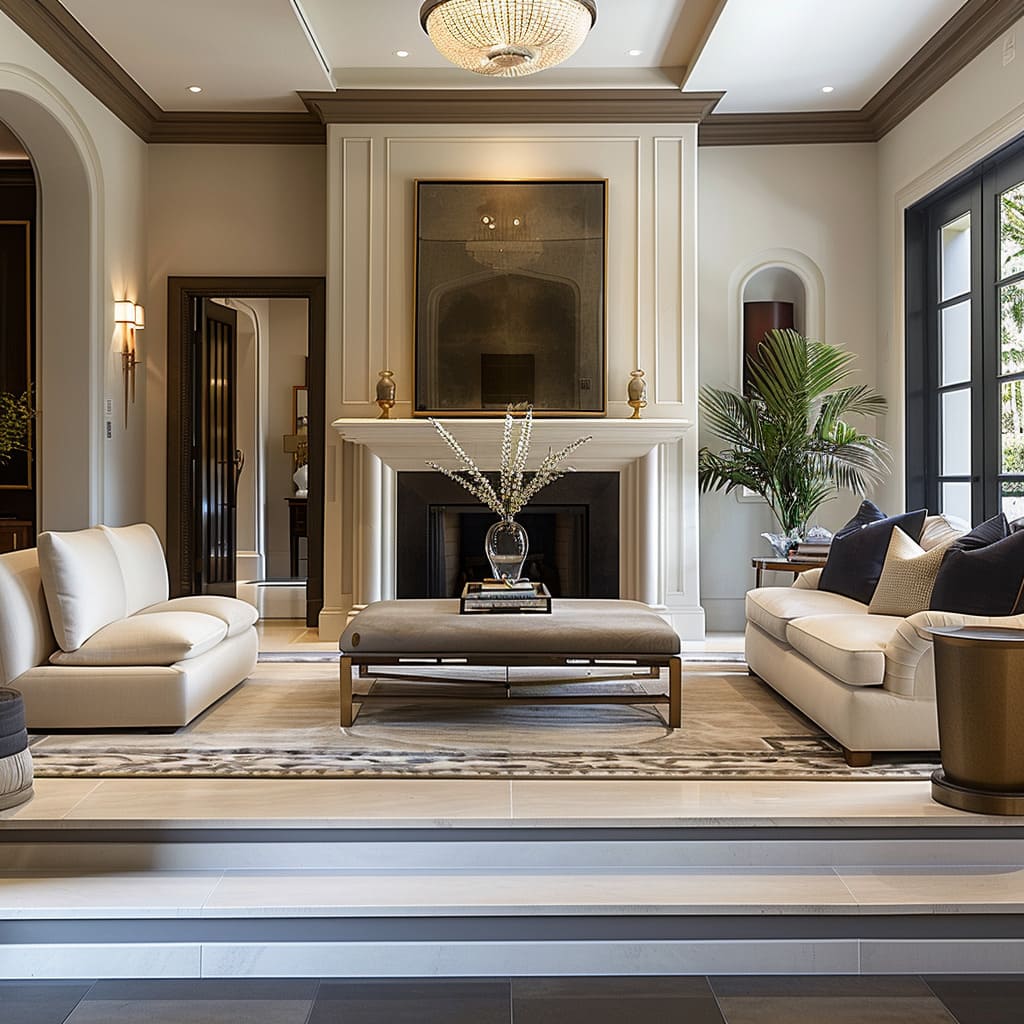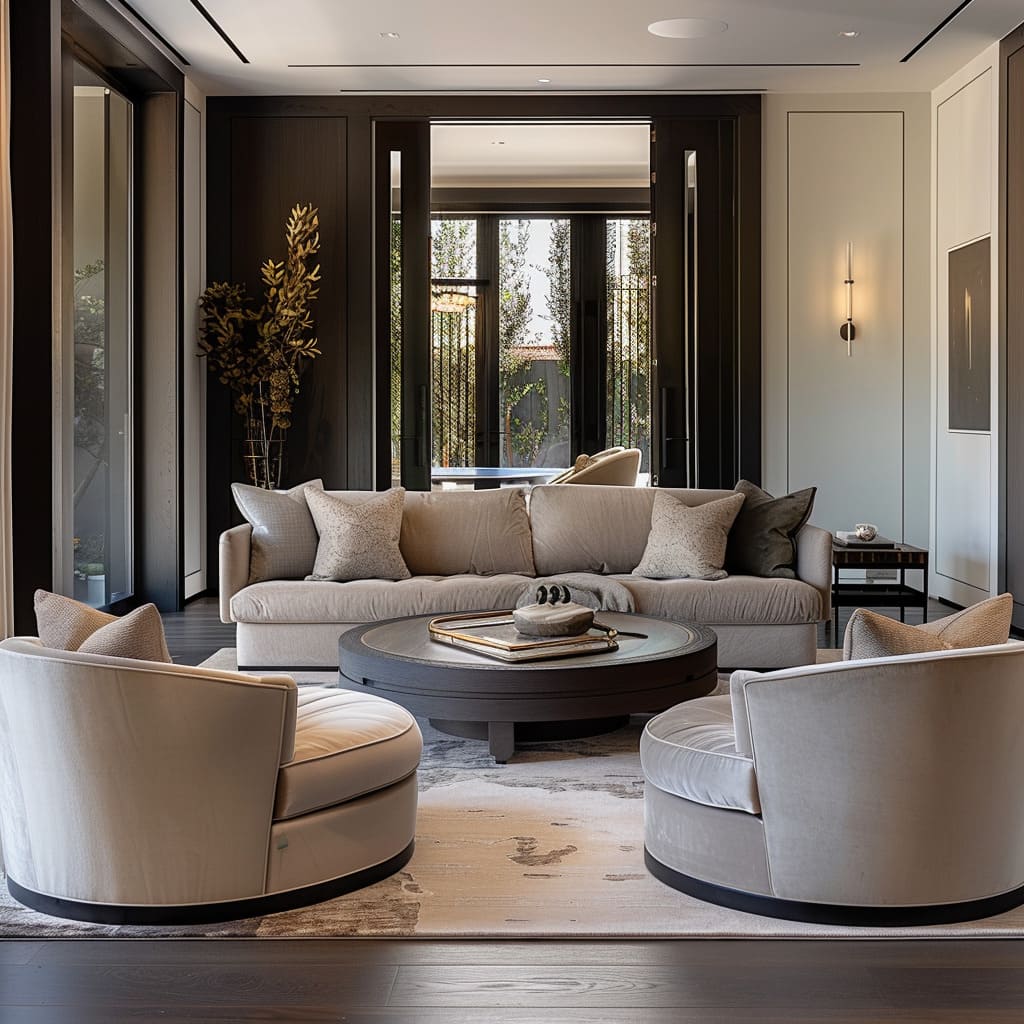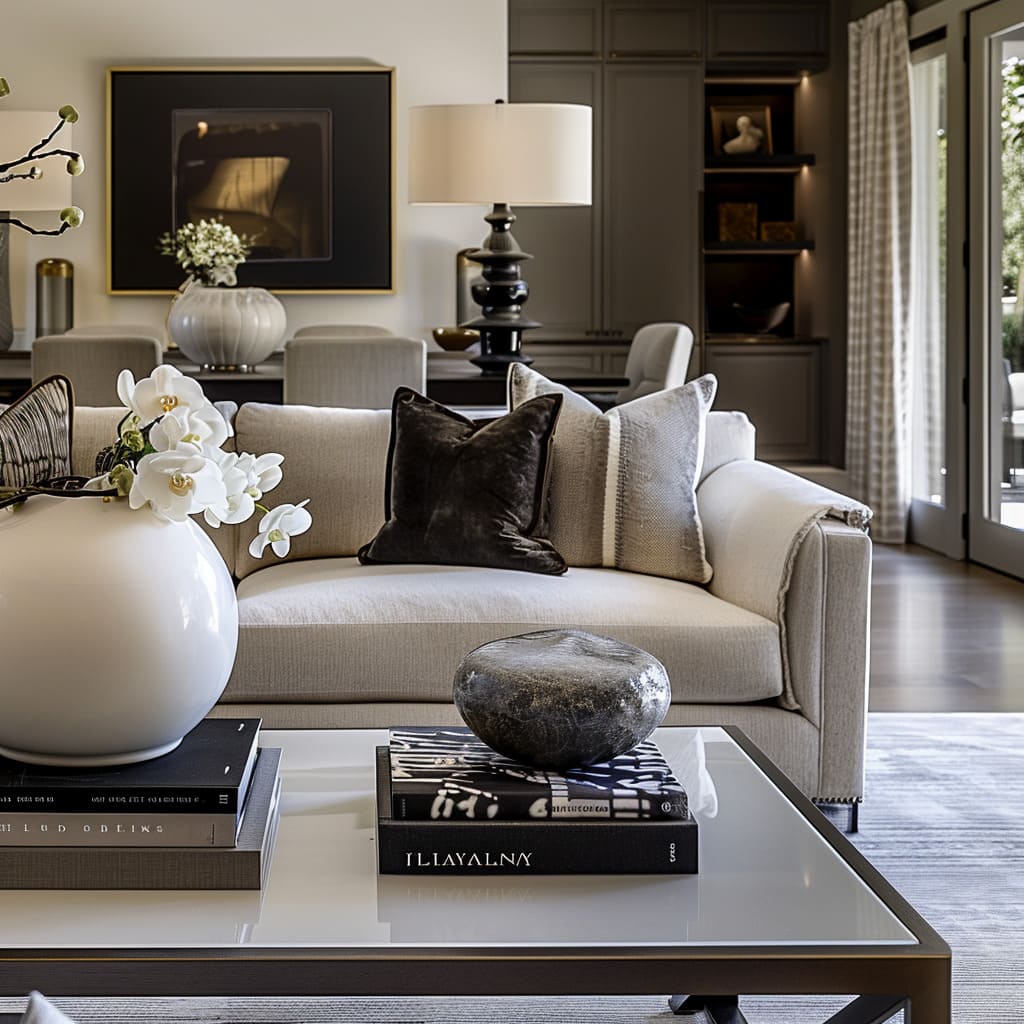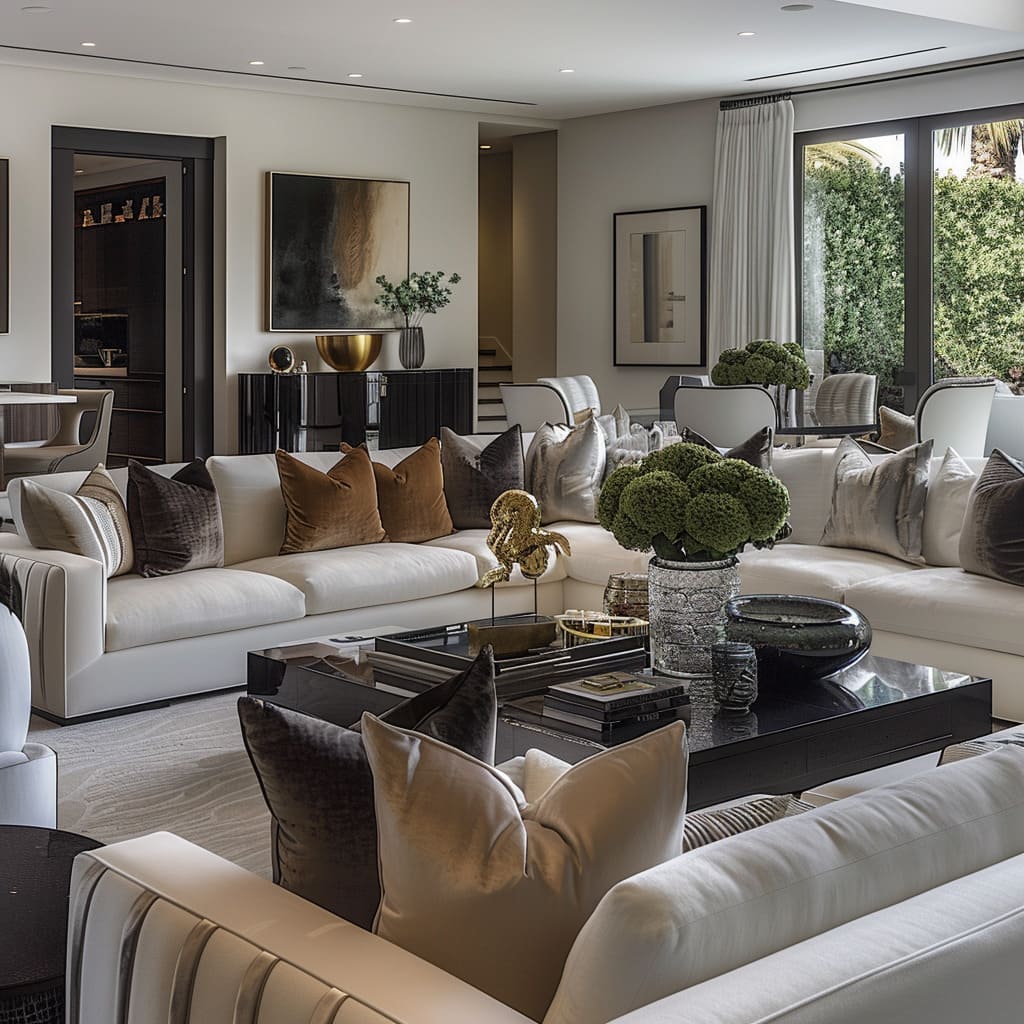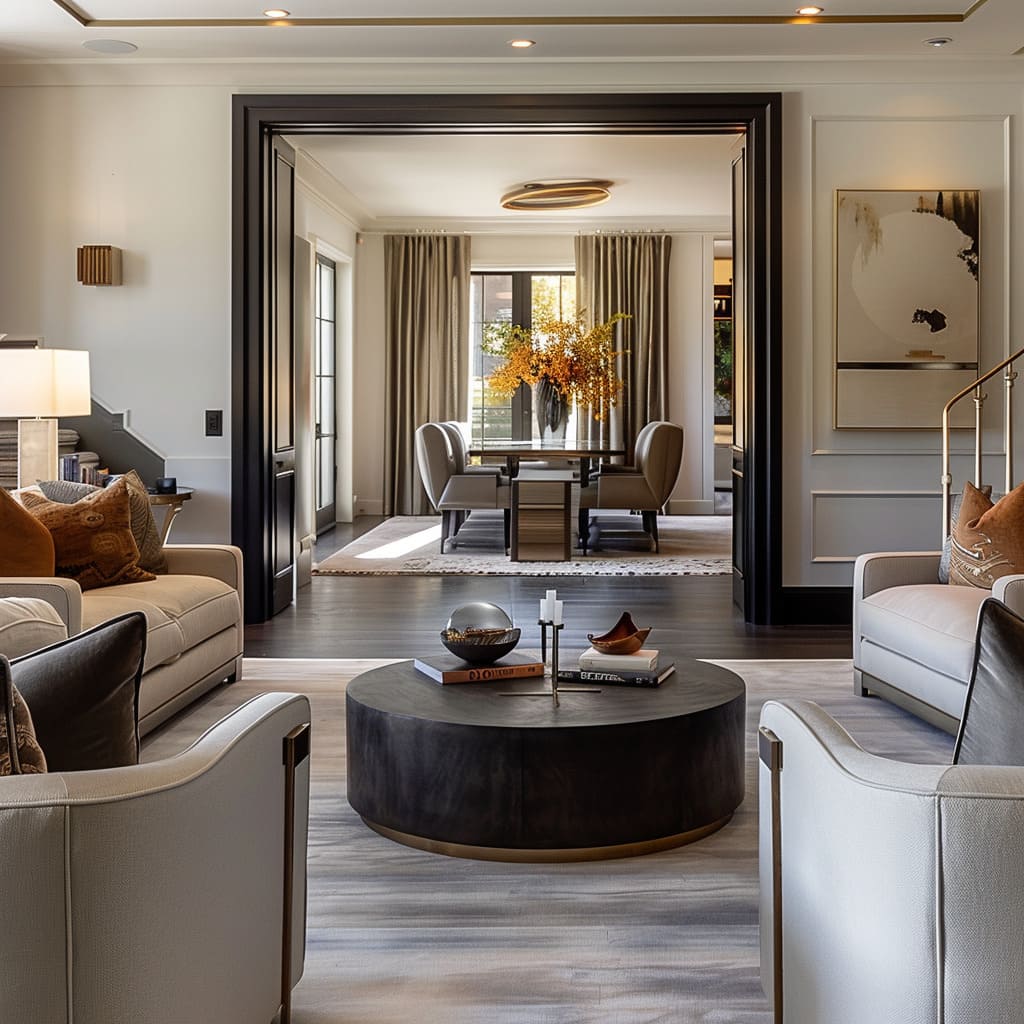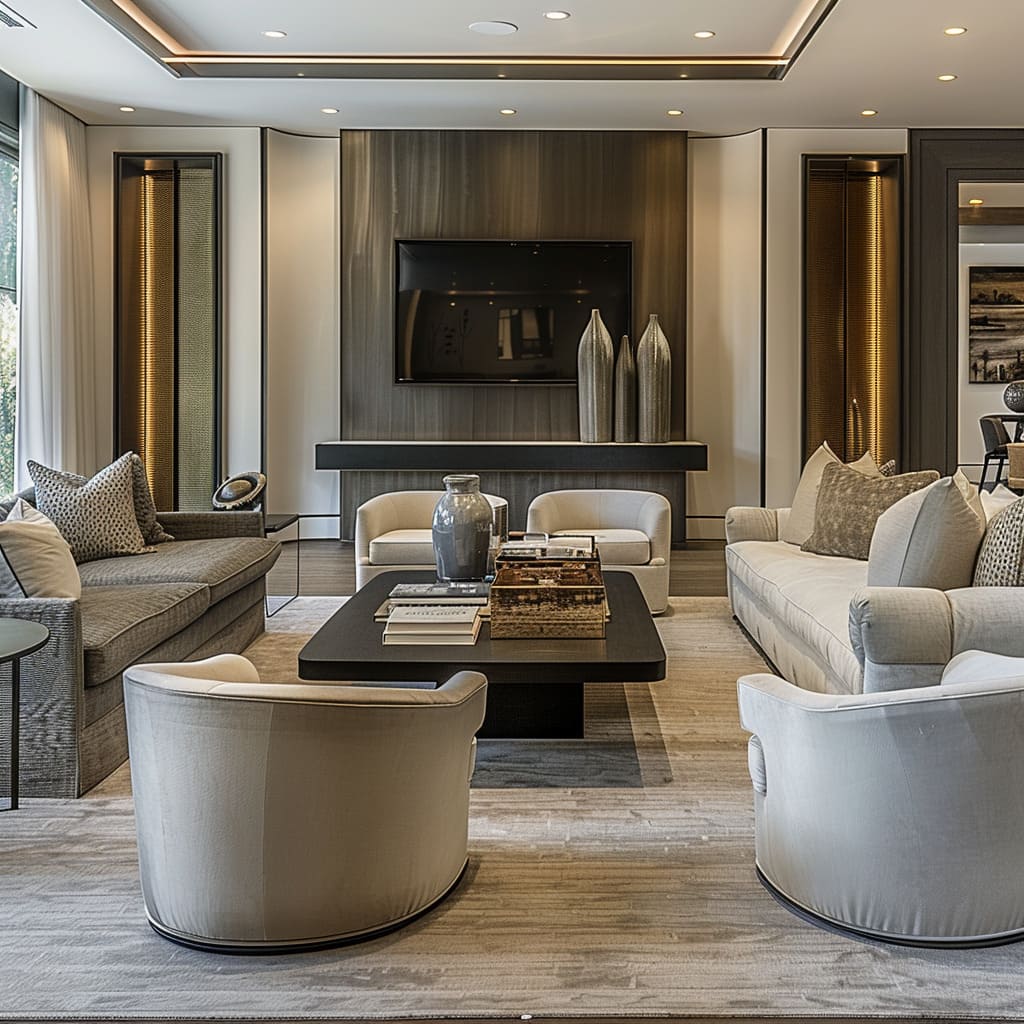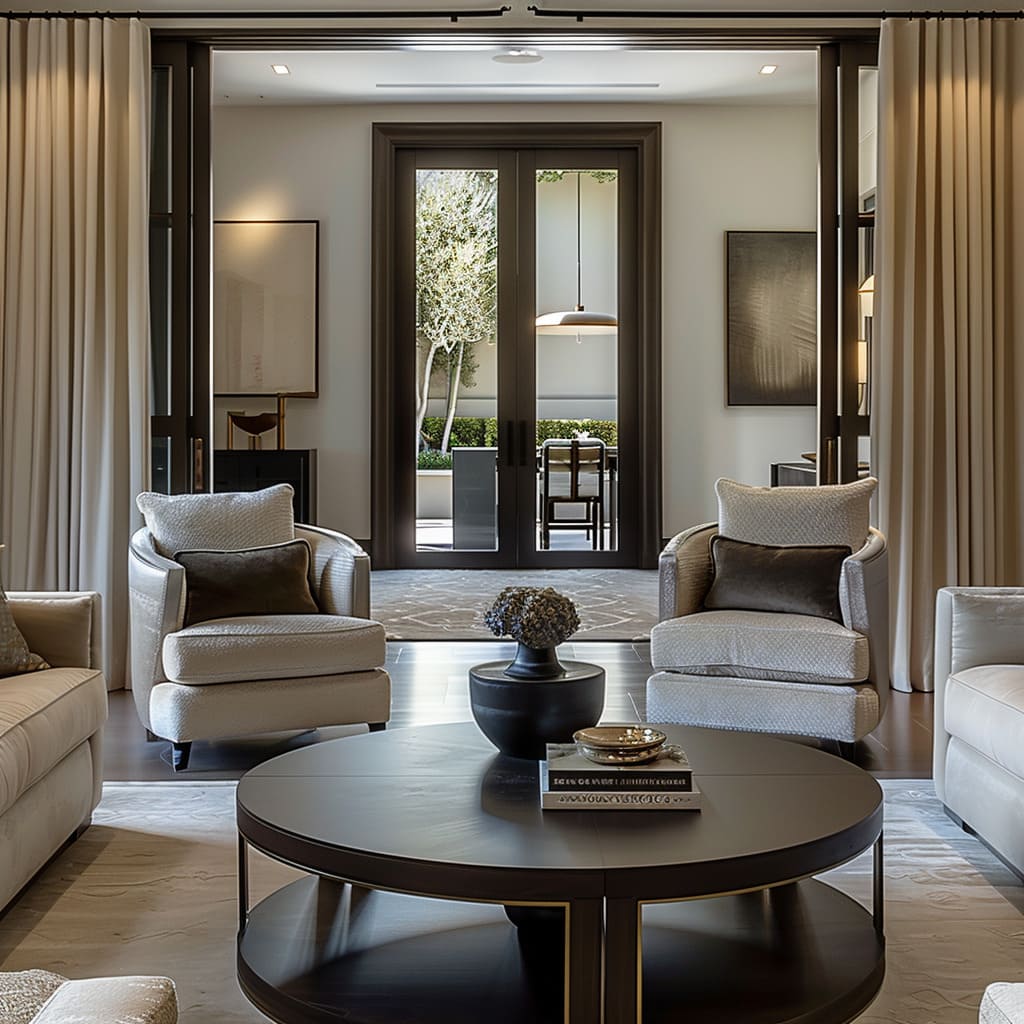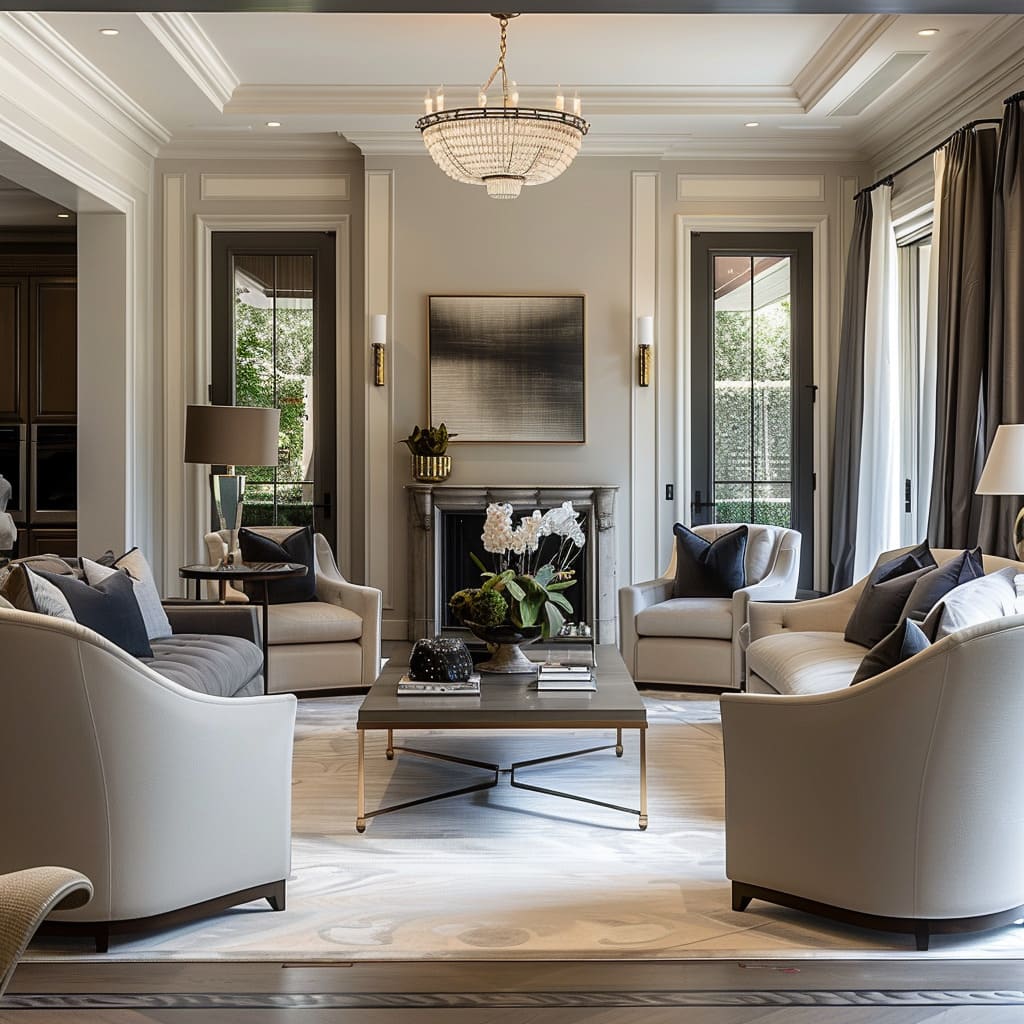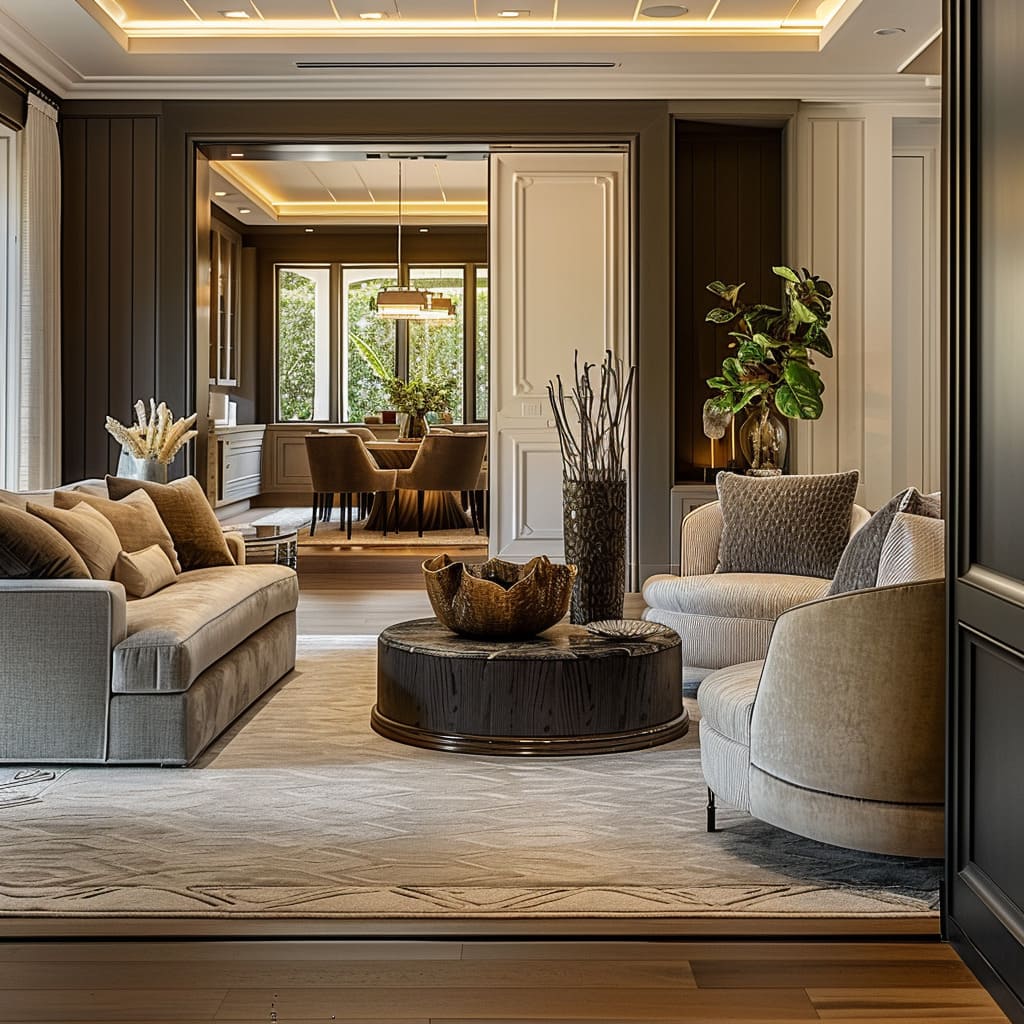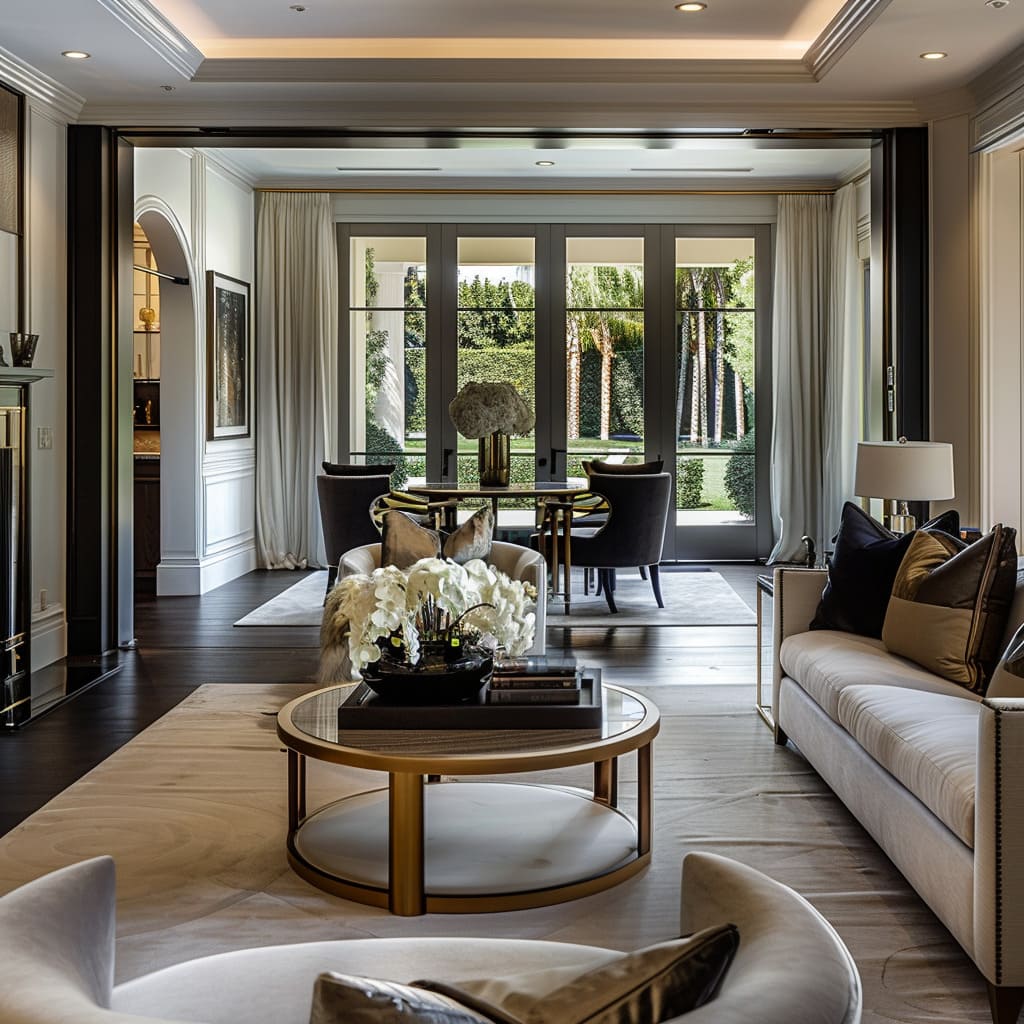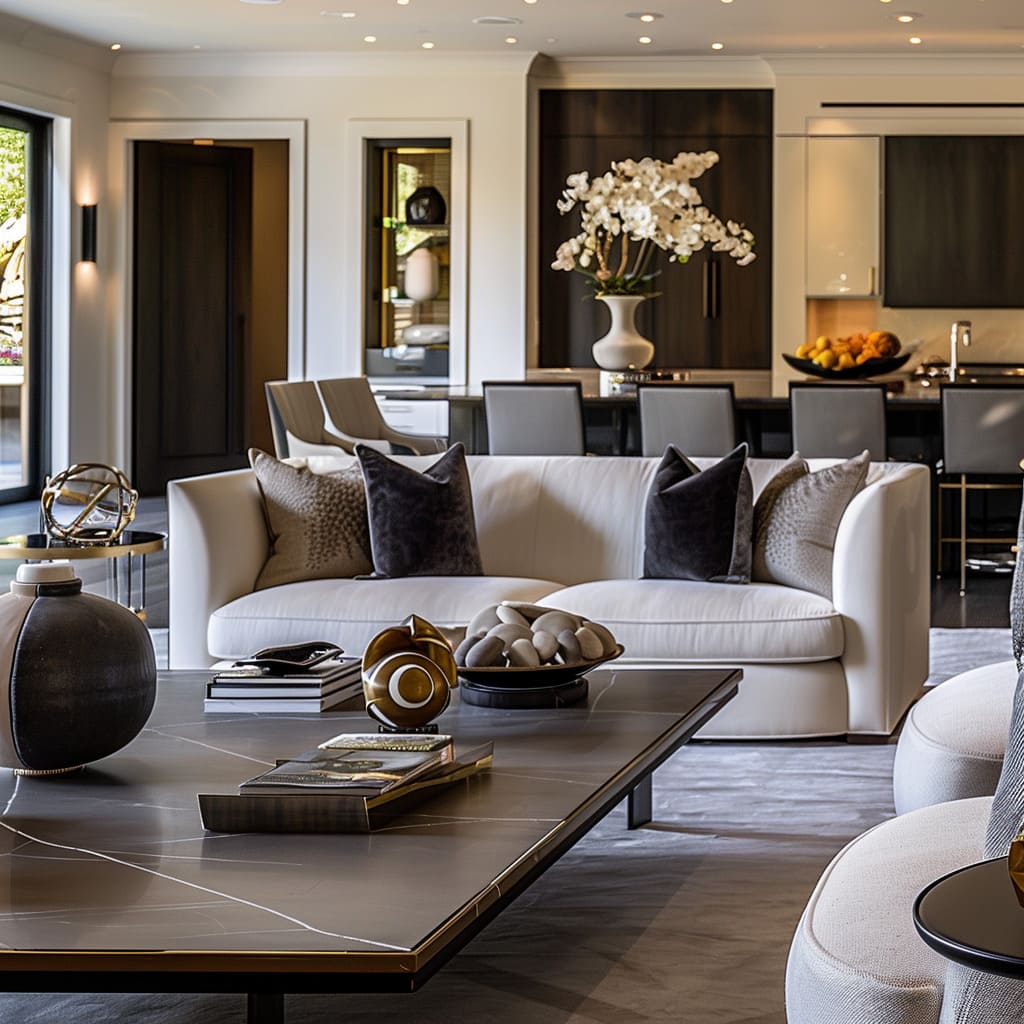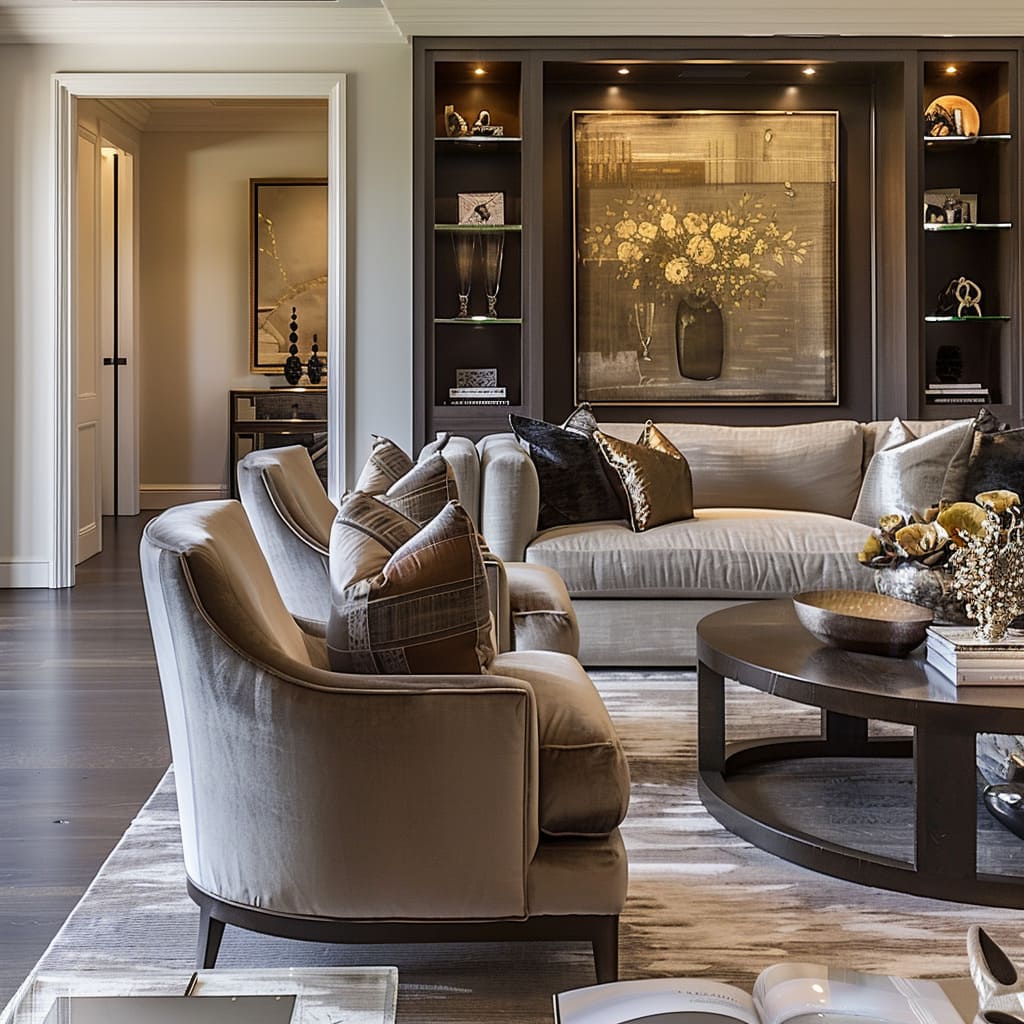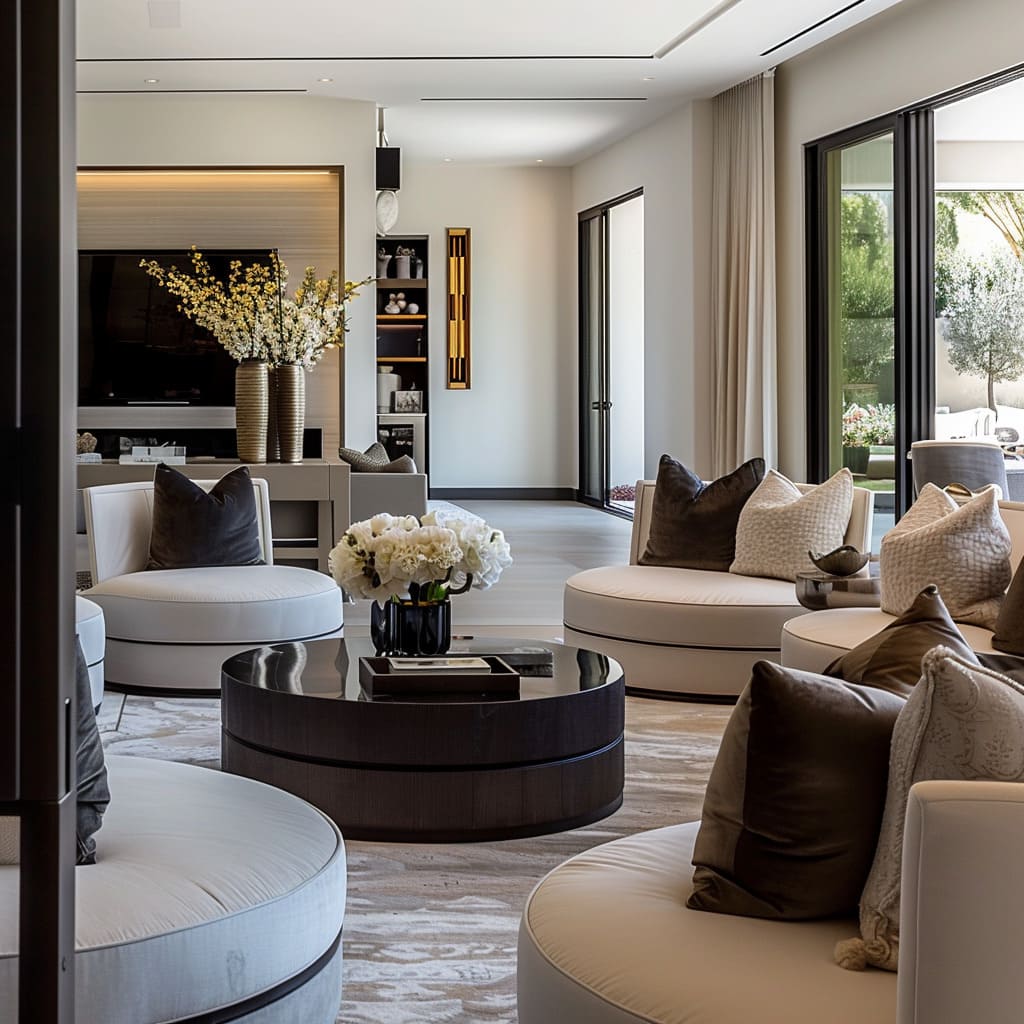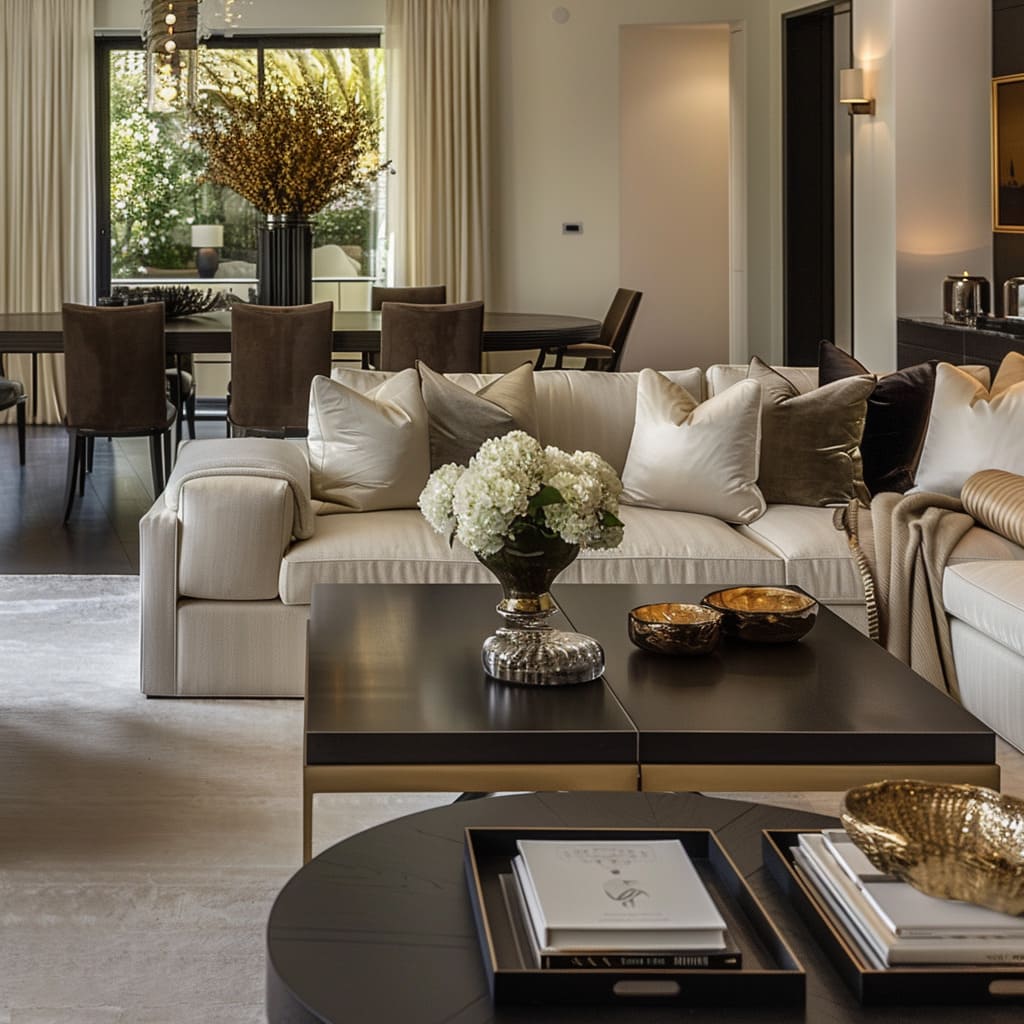In the realm of interior design, creating a space that embodies both style and functionality is an art form. The transitional design style, with its nuanced palette and careful curation of decor, achieves a harmonious balance that resonates with contemporary living.
This article delves into the essence of transitional interiors, where the interplay of colors, textures, and elements culminates in spaces that are not only visually appealing but are also embodiments of comfort and practical elegance. We will explore how the neutral color palette sets a sophisticated foundation, how textures add dimension and warmth, and how a blend of various design periods can coexist to create a timeless aesthetic.
From the subtle infusion of patterns to the strategic use of symmetry and thoughtful incorporation of technology, each component contributes to the unique narrative of a transitional home.
[tta_listen_btn]
Neutral Color Palette
These rooms often feature a neutral color scheme, including shades of beige, cream, taupe, and gray, creating a calming and sophisticated atmosphere. The careful selection of these hues sets a refined backdrop that allows textures and furnishings to stand out.
The neutrality of the palette acts as a canvas, allowing for flexibility in decor changes without the need to repaint or undergo extensive renovations. Walls are typically painted in subtle shades, complemented by similarly toned furniture that exudes elegance.
The neutral colors are chosen not only for their timeless quality but also for their ability to harmonize with natural light that filters through the generous windows. Beige and taupe, especially, add warmth to the rooms, while the various shades of gray provide a modern twist that keeps the design grounded in the present.
Accents such as throw pillows, vases, and artwork are carefully selected to inject subtle contrasts and depth into the space. To implement a neutral color palette in your own space, start with the largest surfaces – walls, floors, and major pieces of furniture – and choose varying shades within a tight color family.
Introduce texture and contrast through smaller decor items and textiles. Remember to consider the natural light in your space, as it can significantly affect how these neutral tones appear throughout the day.
Choose paint with a hint of warmth to ensure the space doesn’t feel too cold or sterile.
Rich Textural Variety
Textures play a significant role in transitional design. These interiors showcase a variety of textures through materials like plush fabrics, polished wood, and shiny metals.
The juxtaposition of soft upholstery against the sleek lines of metal frames or the grain of polished wood adds a layer of sophistication and sensory experience. Textural contrasts are key, with rugs that feature a soft pile set against the smooth, cool surface of marble or hardwood floors.
Further exploring this aspect, the texture is not just tactile but visual as well. Fabrics may feature subtle patterns or weaves that add a sense of depth.
Metals are often used in their brushed or satin finishes to provide a soft sheen rather than a high gloss, which contributes to the overall understated luxury of the space. Wood is selected for its grain and stained to enhance its natural beauty, becoming a feature in its own right.
To incorporate a rich variety of textures in your own home, focus on layering. Combine different materials in your furniture pieces, such as a velvet sofa with leather chairs, or a silk throw on a linen-covered ottoman.
Choose accessories like hammered metal bowls or glazed ceramic vases to add visual interest and tactile diversity. The key is balance – too much of one texture can overwhelm the senses, while a carefully curated selection can create a harmonious and inviting space.
Blend of Traditional and Modern Elements
Transitional design bridges the gap between traditional elegance and contemporary simplicity. You’ll notice classic furniture profiles combined with modern accents.
This might be seen in the shape of an armchair reminiscent of a bygone era paired with a sleek, minimalist coffee table. Or, it might be a traditional chandelier hanging above a room with clean, modern lines.
This blend honors the past while embracing the present.
In these living rooms, traditional elements like coffered ceilings or wainscoting are married with modern art and contemporary light fixtures. Furniture often has a traditional form with a modern finish or fabric, creating a look that is both timeless and of-the-moment.
Color is used sparingly, with the occasional bold hue appearing in an artwork or a single piece of furniture, serving as a statement. To achieve this balance in your own space, start with classic pieces that have simple lines and update them with contemporary finishes or upholstery.
Mix in modern art and accessories to keep the look fresh. It’s important to ensure that neither style overwhelms the other; rather, they should complement and enhance one another.
A well-executed transitional space feels cohesive and intentional, with each piece contributing to a narrative of style evolution.
Subtle Patterns
While patterns are used sparingly, they are often geometric or floral, adding interest without overwhelming the space. Patterns emerge in the details, such as on the throw pillows and area rugs.
These patterns are carefully chosen to complement the neutral color scheme rather than dominate it. They are subtle and often monochromatic, which aligns with the overall serene and cohesive aesthetic of the room.
Delving deeper into this feature, we notice that the patterns are not only confined to textiles but also appear in the wall art and decor pieces. These patterns are harmoniously integrated into the room, providing a sense of continuity.
For instance, a geometric-patterned throw pillow might echo the shape of a modern sculpture or the frame of a piece of furniture, thereby tying the room together. To incorporate subtle patterns into your interior, consider starting with a base of solid colors and then layer in patterns in small doses.
Select a primary pattern that speaks to you and use it in a few key places, ensuring it doesn’t clash with the architecture of the space or the furniture shapes. Consider the scale of the pattern in relation to the room size—smaller spaces typically work better with smaller patterns and vice versa.
What’s Possible Within Your Price Range?
Input Your Budget and See What Dreams Are Within Reach!
[budget_renovation_calculator]
Symmetrical Layouts
The arrangement of furniture and decor often relies on symmetry to create a balanced and harmonious environment. This can be observed in the way pairs of sofas, chairs, and even lamps are positioned to mirror each other.
The symmetry in the rooms provides a formal, organized feel, which is soothing to the eye. It also makes the spaces seem well planned and thoughtful, giving a sense of order and tranquility.
Symmetry extends beyond the furniture layout to include the artwork and window treatments. For example, symmetrical drapery frames the windows, and artwork is centered over furniture pieces or architectural elements like fireplaces.
This approach to design creates a room that feels anchored and stable. To achieve symmetrical layouts in your own space, identify the central focal point of the room—such as a fireplace, window, or a prominent piece of furniture—and arrange pairs of chairs, sofas, or other decor elements equally on either side.
Balance is key, so ensure that the visual weight of the items on both sides of the room feels equal, even if the pieces themselves are not identical.
Sophisticated Lines
Furniture features straight lines mixed with gentle curves, striking a balance between ornate traditional aesthetics and stark modern designs. This is evident in the sleek profiles of sofas that maintain a simple yet plush look, or in the smooth roundness of a coffee table juxtaposed with the clean lines of a modern sideboard.
The furniture is neither too embellished nor too severe, allowing each piece to convey a sense of elegance that is both timeless and contemporary.
Going into more detail, the sophisticated lines also refer to the millwork and structure of the rooms themselves. There is a precision in the way moldings and trim work are executed, with crisp lines that highlight the architecture without being overly decorative.
Doorways, ceiling details, and even built-in shelving exhibit this attention to line and form, providing a subtle complexity to the space. Incorporating sophisticated lines into your own home might start with selecting furniture that boasts a combination of straight and curved elements.
For instance, a sofa with a straight, clean-lined frame could be paired with an ottoman featuring a curved silhouette. When choosing millwork or architectural details, opt for simple profiles that add character without becoming the focal point.
The goal is to create a sense of harmony and understated complexity that feels both inviting and refined.
Plush Upholstery
Seating is typically substantial and plush, providing comfort without sacrificing style. In the rooms depicted, the sofas and armchairs invite relaxation with their deep cushions and soft, enveloping forms.
The choice of upholstery fabric adds to the luxurious feel, with materials like velvet, chenille, and fine leather in evidence. These fabrics are selected not only for their texture and comfort but also for their durability and ability to age gracefully.
Expanding on plush upholstery, the attention to detail in the craftsmanship is evident. Stitching is precise, and cushions are often tufted or feature decorative piping, creating a sense of bespoke elegance.
The color of the upholstery complements the neutral color palette, enhancing the overall design cohesion. To incorporate plush upholstery into your interior, prioritize comfort when selecting your furniture.
Look for pieces with a reputation for quality craftsmanship and choose fabrics that are both soft to the touch and durable. Test out different seating options to ensure they offer the right support and depth for relaxation.
Consider custom upholstery options to get the exact look and feel that suits your space and style preferences.
Metallic Accents
Brass, gold, and chrome are frequently used for light fixtures, hardware, and decorative objects, adding a touch of luxury. The metallic finishes range from polished to brushed, contributing to the layered textural theme.
They catch the light and serve as jewelry for the room, providing an elegant finishing touch. Carefully placed, these metallic elements do not overwhelm but rather punctuate the space with moments of brilliance.
Further detailing metallic accents, we see that their use is strategic; door handles, lamp bases, and frame edges glint with these metals, offering a contrast to the softness of the plush upholstery. In some cases, metallics are used in statement pieces like a large mirror or light fixture, which acts as a focal point for the room.
For your own space, choose metallic accents that complement the existing fixtures in your home for a consistent look. Mix different metallic finishes for a curated, designer feel, but do it with intention to avoid a disjointed aesthetic.
Use metallics in both functional items like faucets and purely decorative pieces like sculptures to weave a thread of luxury throughout your space.
High-Quality Materials
There is a clear emphasis on quality, with materials like marble, hardwood, and high-end fabrics being commonplace. The interiors show that these materials are not just randomly selected but are chosen for their ability to create a refined and durable environment.
Marble is often seen in tabletops or decorative pieces, hardwood floors provide a warm foundation for the design, and fabrics are chosen for their texture and longevity.
Delving into high-quality materials, we note that wood is often used in rich, deep stains that highlight the natural grain, adding a sense of warmth and organic beauty to the space. Fabrics are not only luxurious but also practical, chosen for their ease of maintenance and suitability for everyday use.
To incorporate high-quality materials into your home, invest in the best quality you can afford for key pieces that will see the most use, such as flooring and seating. Choose materials that are not only beautiful but also have a reputation for durability.
Consider the entire lifecycle of the product, from the source of the material to its longevity and potential for repair or refurbishment in the future. High-quality materials are an investment in the comfort, beauty, and lasting value of your home.
Layered Lighting
Multiple sources of lighting, including recessed ceiling lights, lamps, and even chandeliers, create a warm and inviting space. The designs showcase a mastery of ambient, task, and accent lighting, all working in concert to highlight the room’s best features.
Recessed lighting provides a clean, streamlined look, while strategically placed lamps add warmth and intimacy. The chandeliers and pendant lights often serve as both illumination and art, with designs that complement the transitional aesthetic.
The placement of lighting is deliberate, creating not just brightness but also mood and depth. For example, wall sconces may be used to cast a soft glow on a textured wall, while spotlights might highlight a piece of art or architectural feature.
Floor lamps beside seating areas ensure a comfortable space for reading or conversation, proving that functional can also be beautiful. To integrate layered lighting into your interior, start by considering the activities that take place in each area and the mood you wish to create.
Use a combination of overhead, floor, and table lighting to provide both functionality and ambiance. Dimmer switches can be particularly effective in transitional spaces, allowing you to adjust the lighting to suit different times of the day and various occasions.
Statement Art Pieces
Large-scale art pieces often serve as a focal point in each room, reflecting a blend of contemporary and classic styles. Artwork is chosen not only for its visual impact but also for how it complements the overall design scheme.
The art often features a mix of mediums and techniques, bridging the gap between past and present. Whether it’s a large abstract painting, a traditional portrait, or a modern sculpture, the piece commands attention and sets the tone for the room.
The art in transitional design is thoughtfully curated, with an emphasis on quality and originality. It may be framed in a way that echoes other design elements in the room, such as metallic finishes or wood tones.
Positioning is also key, with art placed at eye level to engage viewers and integrate seamlessly into the space. To choose statement art for your home, select pieces that resonate with you personally and complement your existing decor.
Consider the scale of the artwork in relation to your space; large rooms can accommodate oversized pieces, while smaller spaces may benefit from a series of smaller works that create a gallery feel. Allow for plenty of negative space around each piece to let it stand out and speak for itself.
Minimalist Approach to Decor
While the spaces are richly decorated, there is a sense of restraint in the number of decorative items, avoiding clutter. The rooms depicted are thoughtfully appointed, with each accessory chosen for its contribution to the design narrative.
Decorative items are used to add texture, color, and interest, but they are never excessive. The result is a space that feels curated rather than crowded, with a clear focus on quality over quantity.
This minimalist approach extends to furniture as well. Each piece is chosen not just for its aesthetic appeal but also for its functional purpose.
There’s a clear preference for items with a strong silhouette or an interesting material that can stand on their own without the need for excessive embellishment. To adopt a minimalist approach in your decor, be selective about the items you bring into your space.
Focus on acquiring pieces that serve a purpose or bring you joy. Before adding a new item, consider its impact on the overall design and whether it enhances or detracts from the environment you’re trying to create.
Regularly assess your space and remove items that no longer serve your aesthetic or functional needs, keeping the decor fresh and intentional.
Functional Elegance
The design is not only about aesthetics but also about functionality, with each piece often serving a purpose. Furniture is selected for its ability to offer comfort and usability while also contributing to the room’s elegance.
For instance, side tables provide a surface for lighting and accessories, and they often contain drawers for storage. Sofas and chairs are designed for relaxation, with proportions that invite lounging, yet their form maintains a sleek and sophisticated profile.
In expanding upon this, it is clear that functional elegance is achieved through careful selection and placement of furniture. Each piece is scaled to fit the room’s dimensions, ensuring that the space is neither overcrowded nor under-furnished.
The traffic flow is considered, allowing for easy movement through the room, which is essential for a space that is used daily. To integrate functional elegance into your own space, select pieces that are both beautiful and practical.
Consider multi-functional furniture, such as ottomans with storage or nesting tables that can be expanded when entertaining. Each item should serve a clear purpose and contribute to the overall design of the room.
It’s important to maintain a balance between decorative and practical elements to ensure your space remains both attractive and livable.
Custom Cabinetry
Built-in shelves and cabinets are tailored to the space, often painted in neutral tones to blend seamlessly with the walls. The custom units are designed to fit the exact dimensions of the room, maximizing storage and display areas without encroaching on the living space.
Shelving is used to house books and decorative objects, creating a personalized touch, while cabinets hide away less decorative items, maintaining a clutter-free environment.
Further detailing the custom cabinetry, we see that the finishes and hardware are chosen to complement the room’s color scheme and design theme. Whether it’s a matte finish that absorbs light for a softer effect or a glossy finish that reflects it, the cabinetry is as much a part of the decor as it is a functional element.
For those looking to implement custom cabinetry in their own homes, it’s essential to consider both the aesthetic and organizational needs. Work with a designer or a carpenter to create a solution that fits your space perfectly.
Use cabinetry to create a focal point or to subtly enhance the room’s proportions. Choose finishes and hardware that tie in with your overall design scheme to create a cohesive look.
Window Treatments
Drapery is used to enhance privacy and control natural light, with a preference for luxurious materials and understated designs. The window treatments are meticulously chosen to coordinate with the rest of the space, using high-quality fabrics that contribute to the room’s sense of luxury.
The drapery often features clean lines and a tailored look, which provides a sophisticated frame for the views outside.
Delving deeper into window treatments, we notice that they are not just for function but also for form. The way the drapery is hung can affect the perception of the room’s height and scale.
In some cases, curtains are hung close to the ceiling to draw the eye upward and create the illusion of a taller space. To add elegant window treatments to your home, invest in custom drapery that is the right length and width for your windows.
Consider the fabric’s weight and opacity based on how much light you want to filter or block. For a more luxurious look, choose fabrics with a subtle texture or sheen, and always hang curtains as high as possible to elevate the room’s overall feel.
Remember that window treatments are not only functional but can also be a statement piece in your design.
Use of Reflective Surfaces
Mirrored, glass, and glossy finishes are strategically used to reflect light and create a sense of depth. The living spaces depicted make use of reflective surfaces in various forms, from mirrored panels on walls to glass-topped tables and shiny metallic decor items.
These elements serve to bounce light around the room, enhancing the natural brightness and giving an airy feel to the spaces. They also contribute to the illusion of a more expansive room, making them especially effective in smaller or darker spaces.
Reflective surfaces are often placed opposite windows or other light sources to maximize their effect. They are also used in artwork, with pieces featuring glossy finishes that catch the eye and add a dynamic quality to the room.
Even the flooring has a reflective quality, with polished hardwood or high-gloss tiles that contribute to the overall lightness of the space. To incorporate reflective surfaces into your interior, consider the interplay of light and reflection in your space.
Position mirrors to reflect natural light, and choose furniture with glass or glossy elements to enhance this effect. Even small touches, like a collection of metallic vases or a lacquered tray, can add sparkle and depth to your room.
Be mindful of what is being reflected; ensure that mirrors and glossy surfaces present pleasing views that enhance the room’s aesthetics.
Large Area Rugs
Rugs are often large and understated, providing a soft texture underfoot and defining the seating areas. In these interiors, the rugs complement the neutral color scheme, often in muted tones or subtle patterns that do not overwhelm the visual palette.
They are proportioned to fit the seating arrangement, anchoring the furniture and delineating zones within the larger room. Besides providing comfort and warmth, these rugs contribute to the acoustic quality of the space by softening sound.
Looking closer, the textures of the rugs range from thick, plush piles that invite bare feet to flatter weaves that offer ease of maintenance. Their placement is considered to ensure they contribute to the flow of the space, often extending under furniture to tie the various elements together cohesively.
When choosing area rugs for your home, consider the scale of your room and the arrangement of your furniture. Select a rug that is large enough to fit under the main pieces of furniture but does not overpower the room.
Stick with colors and patterns that harmonize with your overall design scheme and choose a texture that suits your lifestyle and comfort preferences.
Decorative Molding
Crown molding, wainscoting, and other architectural details add depth and character to the rooms. These elements are used to frame the space, drawing the eye upward and creating a finished look.
The molding is often painted in the same color as the walls for a seamless look that emphasizes the room’s proportions. Wainscoting adds a layer of texture and traditional charm, while baseboards and trim work to define the architectural lines of the space.
The decorative molding is both understated and impactful, adding a layer of sophistication without becoming the center of attention. It complements the transitional style by bridging classic architectural beauty with modern design sensibilities.
To add decorative molding to your own space, first consider the style and scale of your room. Select molding profiles that are in proportion to your ceiling height and room size.
For a more modern look, opt for simpler profiles, or for a traditional touch, choose more detailed designs. Paint molding in a color that either blends with the walls for a subtle effect or contrasts slightly for more definition.
Consider the overall impact of the molding on your space, ensuring it enhances rather than overwhelms the room’s design.
Mix of Furniture Styles
Transitional rooms often feature a curated mix of antique pieces alongside contemporary designs. This mix not only adds visual interest but also creates a layered and evolved look that suggests a collection amassed over time.
One may find a classic wingback chair paired with a sleek modern sofa or an ornate vintage mirror above a minimalist console table. The interplay of different eras and styles adds depth and personalization to the space.
Looking closer at the details, it’s evident that the antique pieces often have a story or a patina that adds character and warmth to the rooms. These pieces are carefully restored or maintained to preserve their historical charm while being functional in a modern setting.
Contemporary pieces, on the other hand, provide clean lines and modern comforts, creating a balance between old and new. To incorporate a mix of furniture styles in your home, start by selecting a few key antique pieces that you love and that have a timeless appeal.
Integrate these with more modern items that have simple, clean lines. Ensure that there is a common thread that ties the different styles together, such as a consistent color scheme or material that is repeated throughout the space.
The goal is to create a cohesive look where each piece feels like it belongs, despite their differing origins.
Emphasis on Comfort
Comfort is key in transitional design, with furniture and layouts designed to be inviting and practical. The seating is often plush, with generous proportions and soft, luxurious fabrics that invite one to sit and relax.
The layouts prioritize ease of movement and conversation, with furniture arranged to foster social interaction without feeling cramped. Even in the most sophisticated of rooms, comfort is not sacrificed for style.
Comfort extends beyond just the furniture. The rooms are designed with a human scale in mind, ensuring that the environment feels cozy and welcoming.
Soft throws, cushioned rugs, and adjustable lighting all contribute to a sense of well-being and relaxation. To ensure comfort in your own space, choose furniture that is ergonomically designed and that suits your body type and lifestyle.
Arrange your seating to create intimate conversation areas and make sure there is ample room to navigate the space without obstruction. Incorporate soft textiles and adjustable lighting to enhance the feeling of comfort, and choose quality materials that will stand up to daily use.
Harmonious Use of Space
The design ensures that the space is not overcrowded, allowing each piece of furniture and decor to stand out. The layouts are thoughtfully planned to allow for both aesthetic appeal and functional use.
Each item has its place and purpose, contributing to a sense of order and tranquility. In the transitional interiors, there is a balance between furnished areas and open space, ensuring that the room feels neither sparse nor cluttered.
The harmony in these spaces is achieved through careful consideration of scale and proportion. Furniture is selected not only for its look but also for its fit within the room’s dimensions.
Negative space is respected as much as the furniture itself, allowing the eye to rest and the design to breathe. To achieve harmonious use of space in your own home, be intentional about what you bring into each room.
Avoid the temptation to fill every corner, instead allowing each piece of furniture room to stand on its own. Use scale and proportion to guide your furniture choices, and consider the flow of movement throughout the space.
Aim for a balance that feels right, offering both utility and visual respite.
Integrated Technology
Modern amenities, such as flat-screen TVs and smart home devices, are integrated without disrupting the aesthetic flow. Technology is seamlessly incorporated into the design; televisions are often wall-mounted and framed to look like pieces of art when not in use, and speakers are discreetly placed to blend in with the decor.
Smart home systems are likely embedded to control lighting, temperature, and entertainment systems, enhancing the room’s functionality without compromising on style.
Looking more closely at the integrated technology, we see that devices are chosen for their sleek design as well as their functionality. Wires are hidden within walls or furniture, and tech devices are often the same color as their surroundings to minimize visual disruption.
Lighting systems can be programmed to change throughout the day, complementing the natural light and setting the mood for different times and occasions. To integrate technology into your own home, start by identifying the tech needs that match your lifestyle.
Opt for devices with a minimalist design and consider custom solutions to hide or disguise your technology. Use smart systems that can be controlled via a phone or voice commands to maintain a clutter-free environment.
The goal is to enhance your living experience without the technology becoming the focal point of the space.
Thoughtful Composition
Every item seems carefully chosen and placed, with a focus on proportion and scale. In these interiors, furniture is arranged to create balance and harmony within the space.
Decorative items are scaled to fit their surroundings, with larger pieces on substantial surfaces and smaller items grouped together to create vignettes. Artwork is hung at eye level, and spacing between pieces is consistent, allowing each to be appreciated individually.
Further examining the thoughtful composition, there’s an evident flow in the arrangement of the rooms. There is a visual hierarchy, with larger, more impactful pieces drawing the eye, and smaller, subtler items serving as complements.
The spacing between furniture and decor allows each piece to ‘breathe’ and contributes to an uncluttered look. To achieve a thoughtful composition in your home, consider the balance of the room when placing each item.
Use a mix of heights and sizes to create interest, and group related items together to form cohesive arrangements. Hang art at a height where it can be enjoyed from a seated or standing position, and don’t be afraid to leave some walls bare to avoid visual overload.
Touch of Nature
Whether through plants, flowers, or natural light, there is often an element that connects the interior to the outdoors. Large windows allow for abundant natural light, which brings a bit of the outdoors inside.
Plants are used as decor, providing a living element that changes and grows. Flowers, whether fresh or in artwork, add a splash of natural beauty and can be used to introduce subtle color into the neutral palette.
In the deeper layers of these designs, the touch of nature is more than just an aesthetic choice; it promotes wellbeing and a sense of calm. The use of organic materials, like wood and stone, further strengthens the connection to the natural world.
Even the color choices often echo those found in nature, with earthy tones and textures that remind one of outdoor elements. For incorporating nature into your space, consider where you can add greenery or florals in your home.
Even in low-light conditions, there are plants that can thrive. Use organic materials for your furnishings or finishes when possible, and maximize natural light through the strategic placement of mirrors and reflective surfaces.
Let the outside view be a part of your interior decor by keeping windows unobstructed.
Versatile Spaces
These rooms are designed to be versatile, easily transitioning from a place of relaxation to an area suitable for entertaining guests. The furniture is often modular, allowing for different configurations, and seating is ample and varied, from sofas to chairs to ottomans.
The open floor plans seen allow for a flow between spaces, making it easy to adapt the area for different uses, whether it’s a quiet evening at home or a lively gathering. Delving into the versatility of these spaces, one notes the strategic use of movable pieces like side tables and serving carts, which can be repositioned as needed.
The rooms are equipped to serve multiple purposes, with areas for lounging, dining, and entertainment.
To create versatile spaces in your home, opt for furniture that can serve multiple purposes, such as a dining table that can double as a workspace, or a daybed that can serve as seating during the day and a bed for overnight guests. Consider the flow of your space and arrange it to allow for easy movement and adaptability.
Keep essentials for entertaining, like extra seating or tableware, stored within reach to make the transition from daily living to hosting effortless.
The transitional design style, with its adept blending of classic and modern influences, offers a versatile and enduring approach to creating a home that is both elegant and welcoming. As we have seen, the key lies in the thoughtful selection of a neutral color palette, the strategic layering of textures, and the careful balancing of furniture and decor.
By incorporating elements such as plush upholstery, metallic accents, and high-quality materials, we can craft spaces that are not only visually stunning but also deeply comfortable and functional. Whether through the integration of technology, the placement of art, or the inclusion of natural touches, a transitional home is a testament to the beauty of balance and the power of subtle details.
With these principles in mind, anyone can create a living space that feels curated, cohesive, and, above all, personal. The transitional style is not just a method of design; it’s a means of expressing one’s journey through the art of interior composition, where every choice is a reflection of individuality and every detail has its place in the grand tapestry of home.


